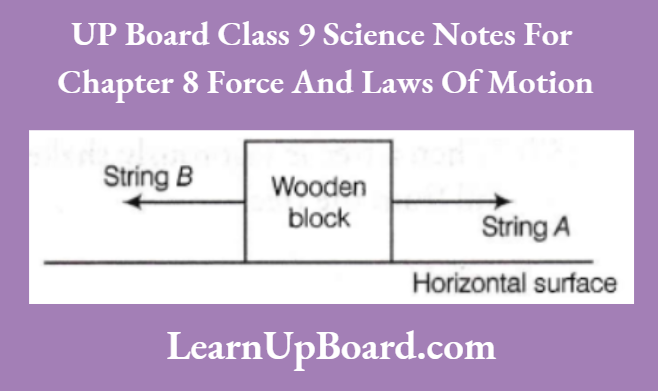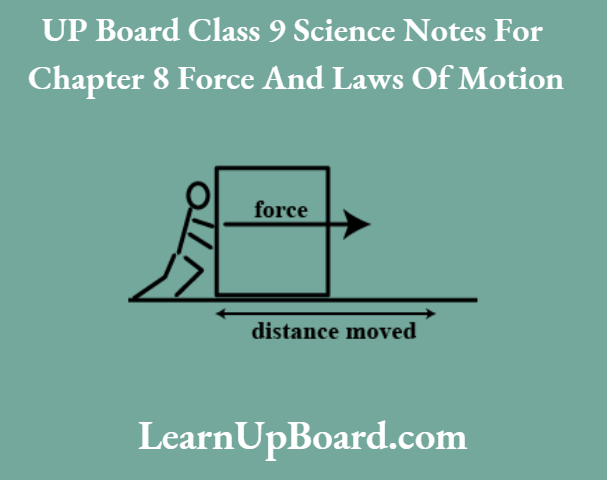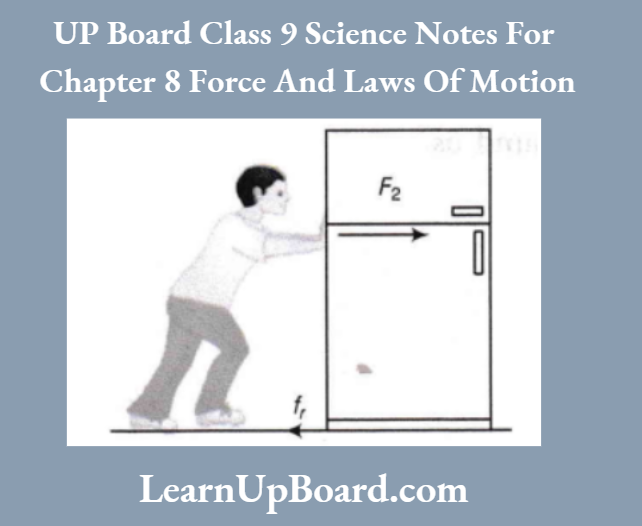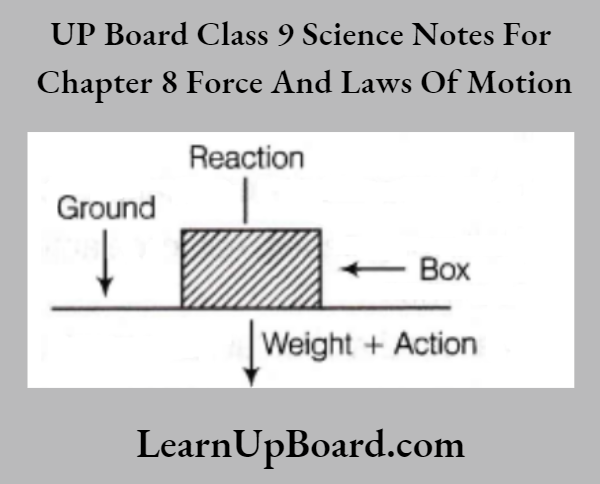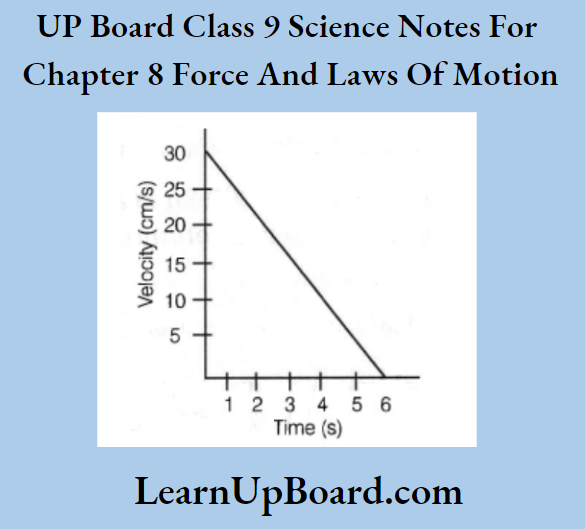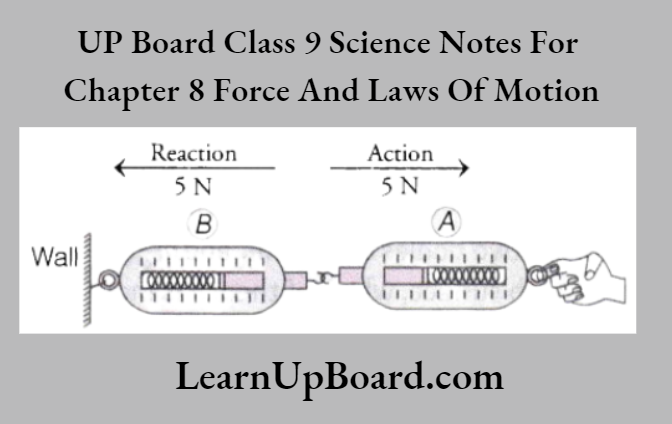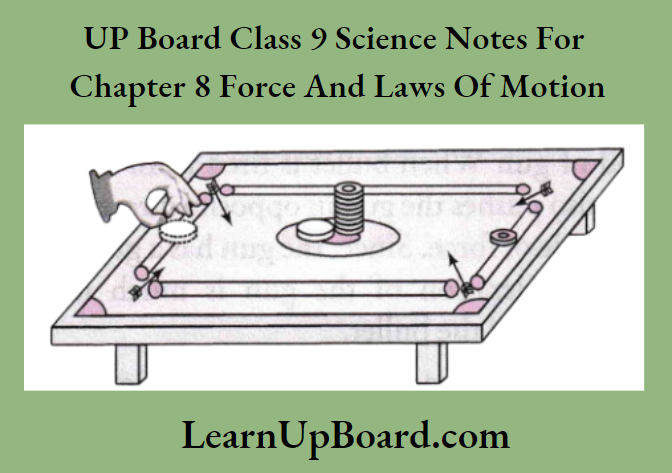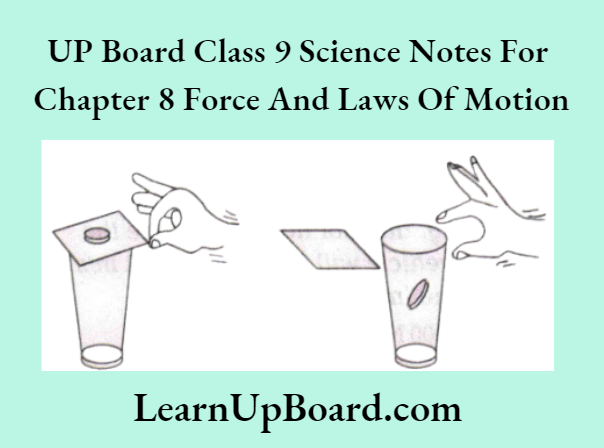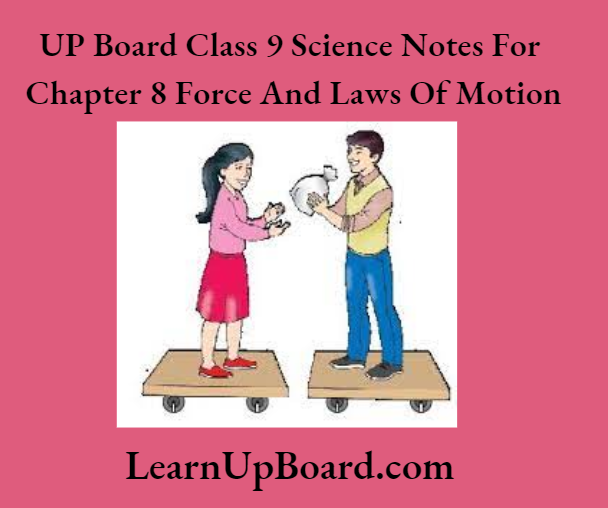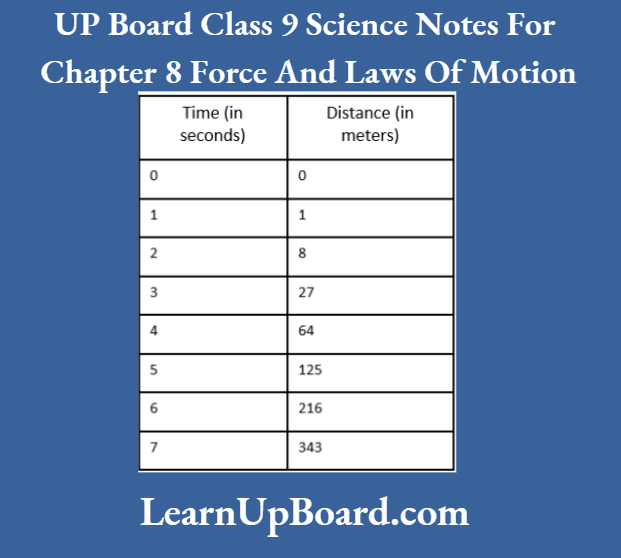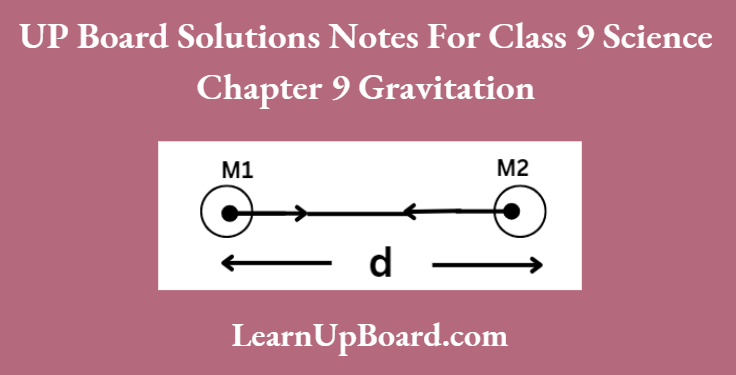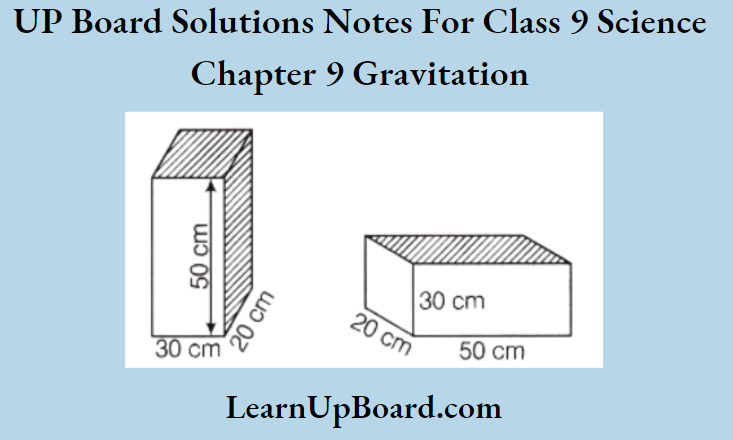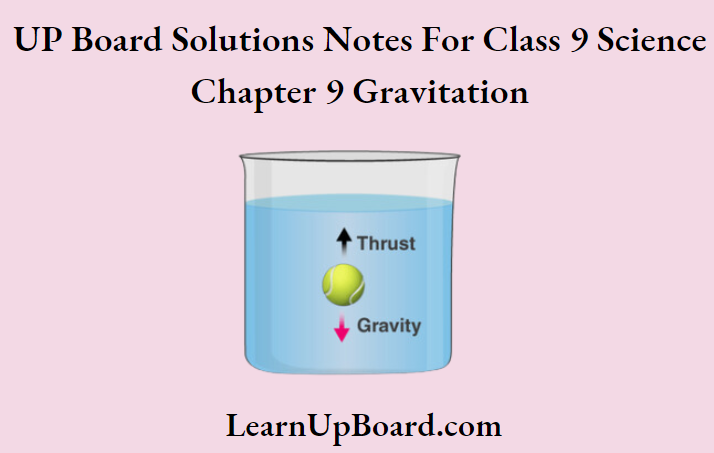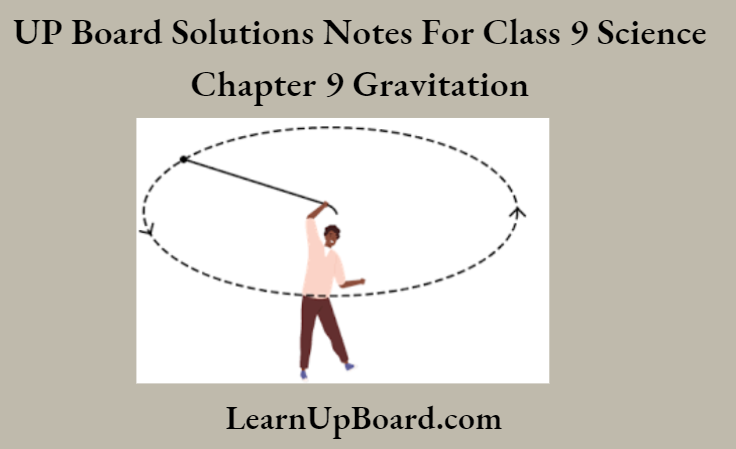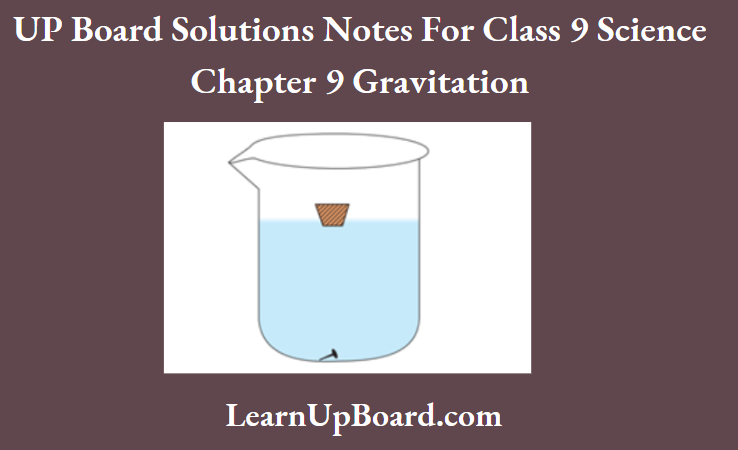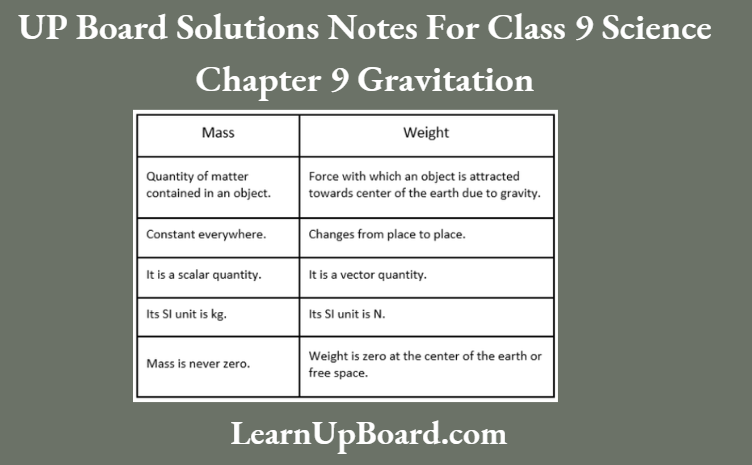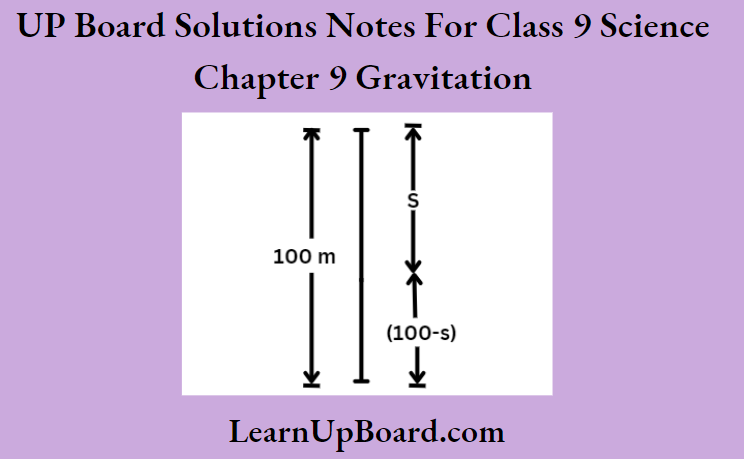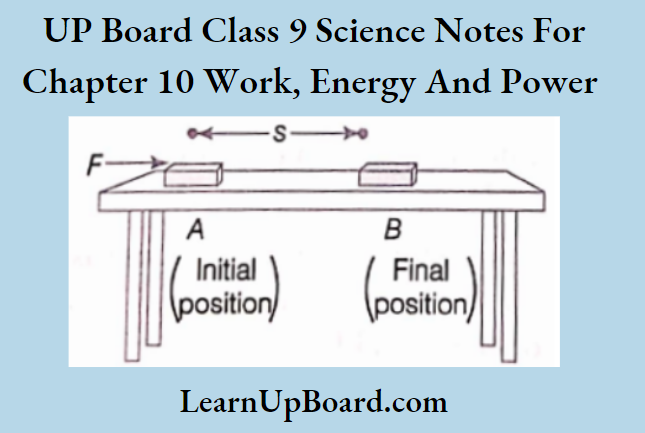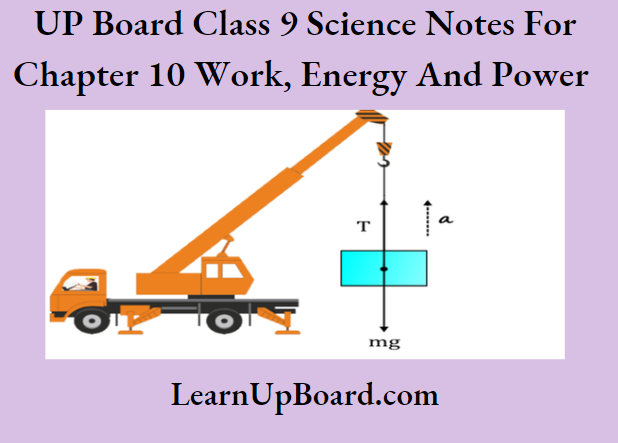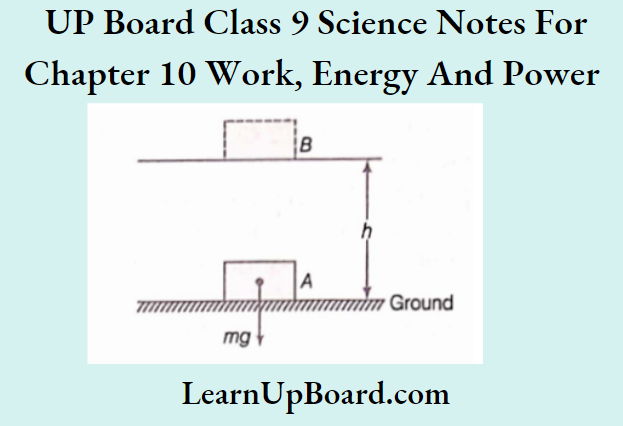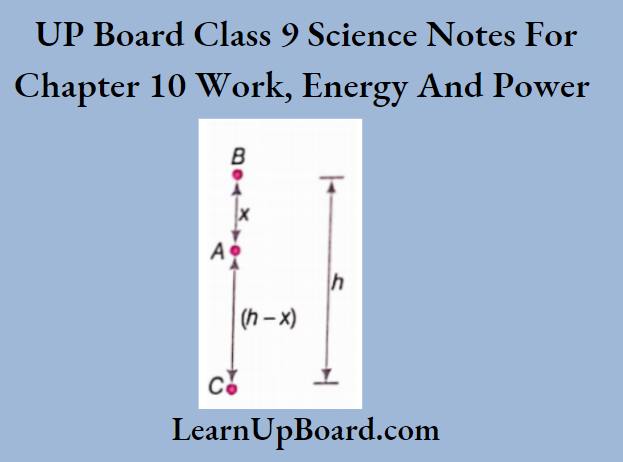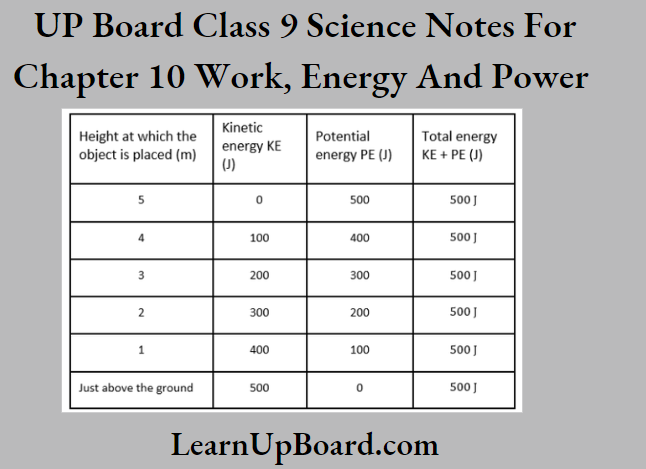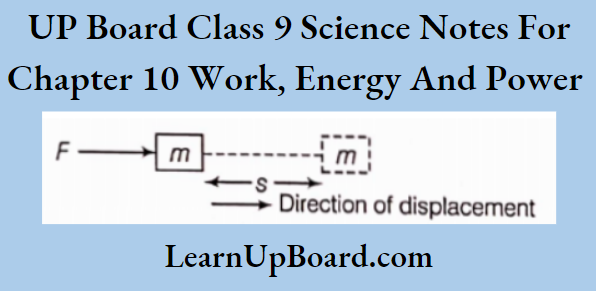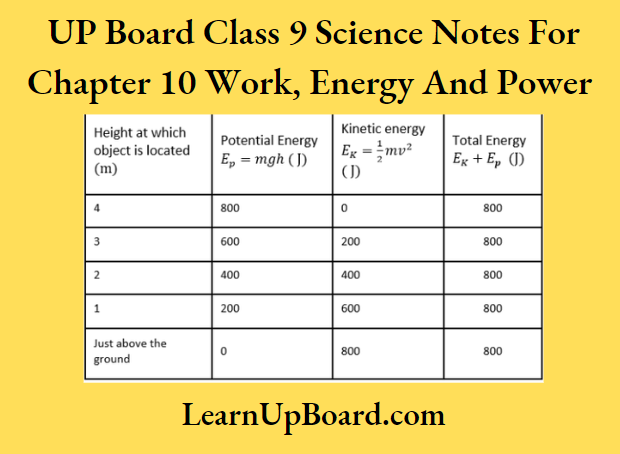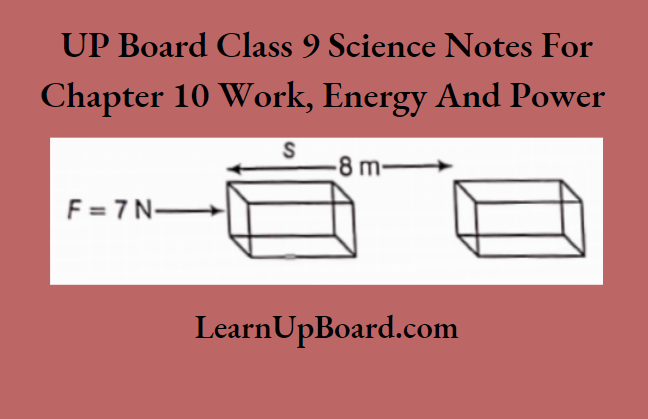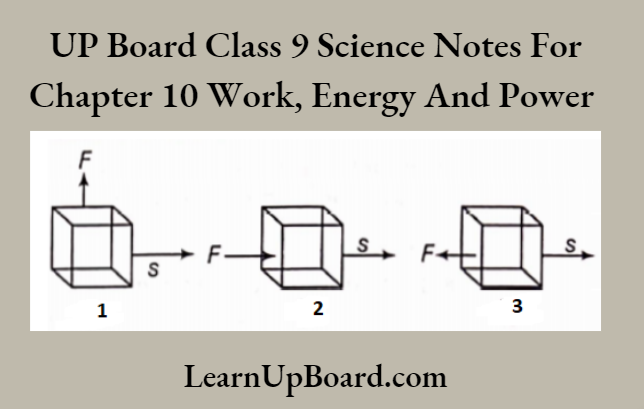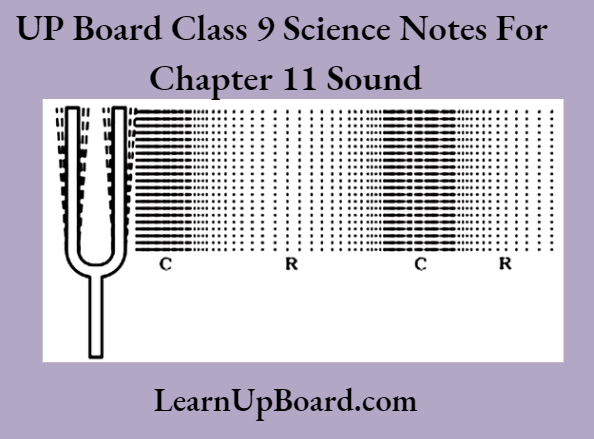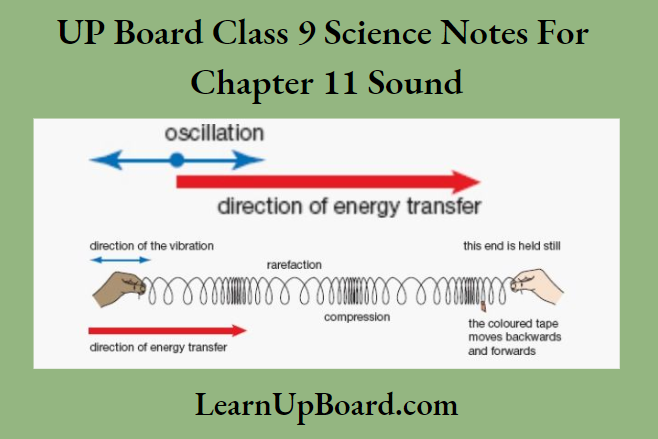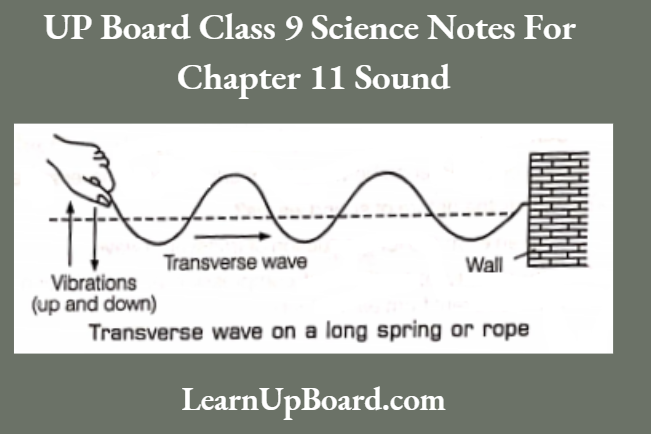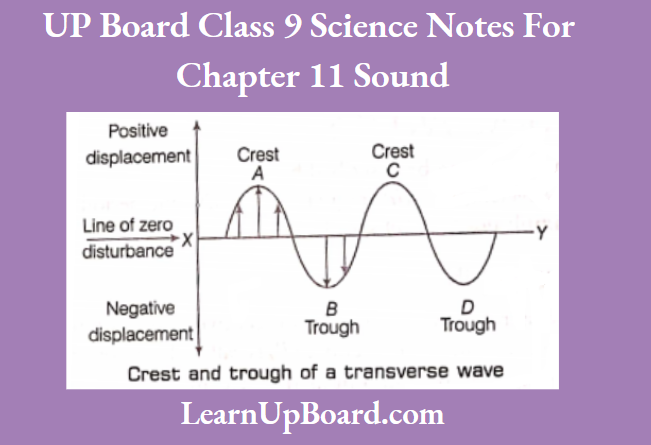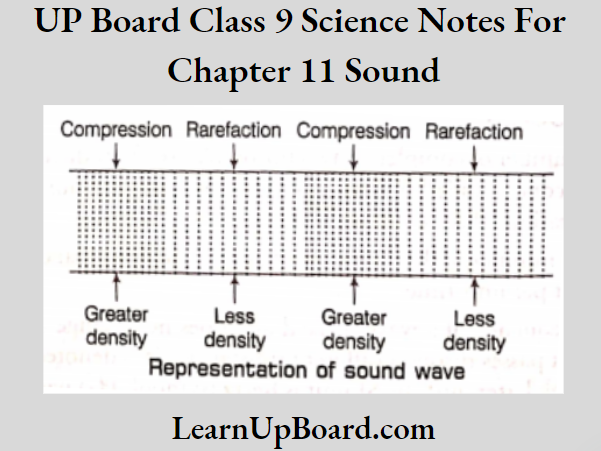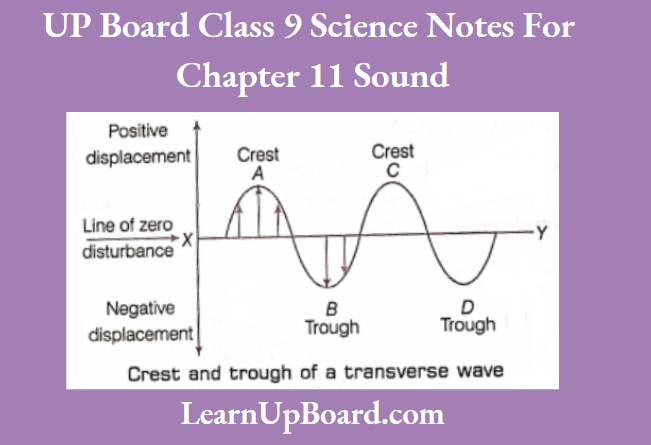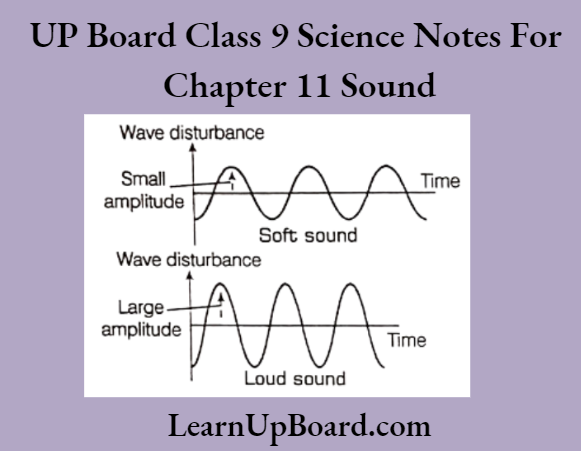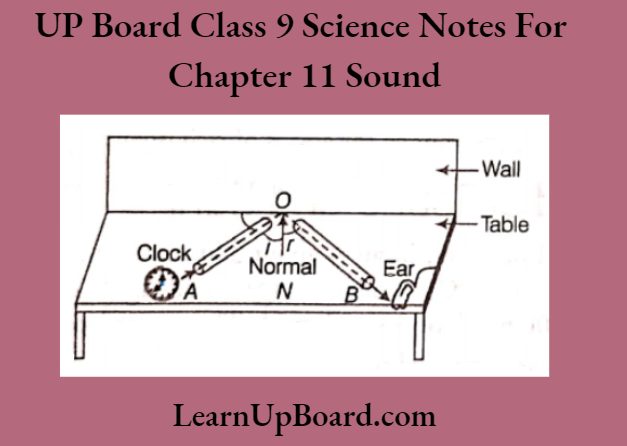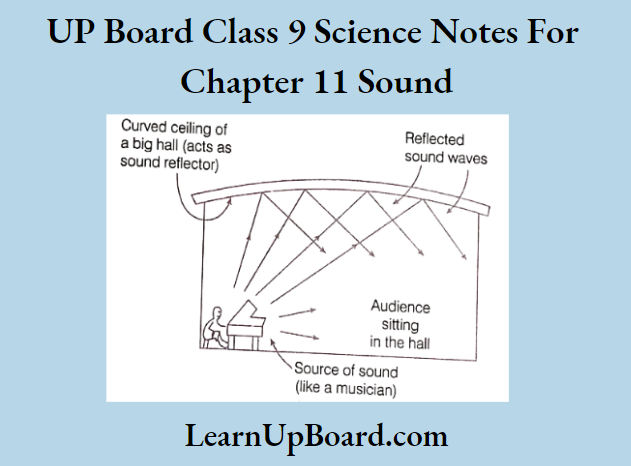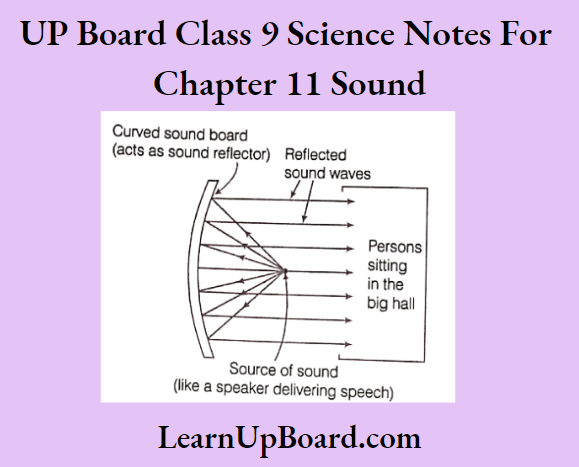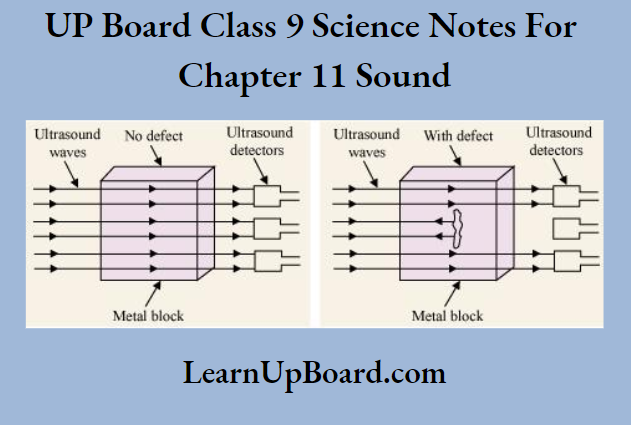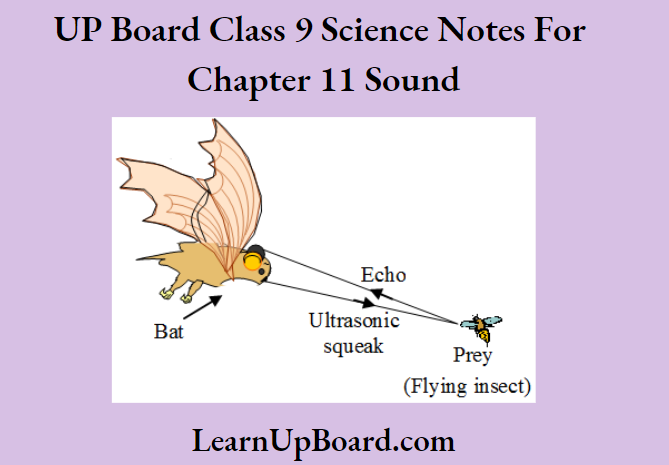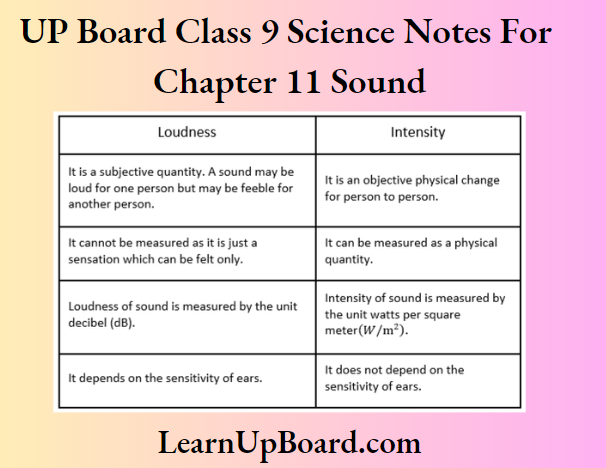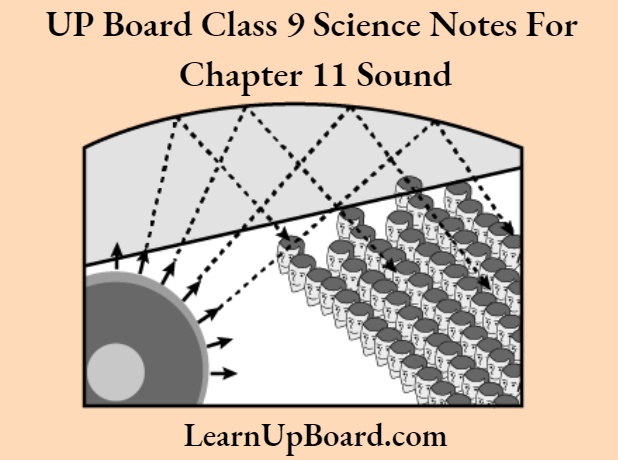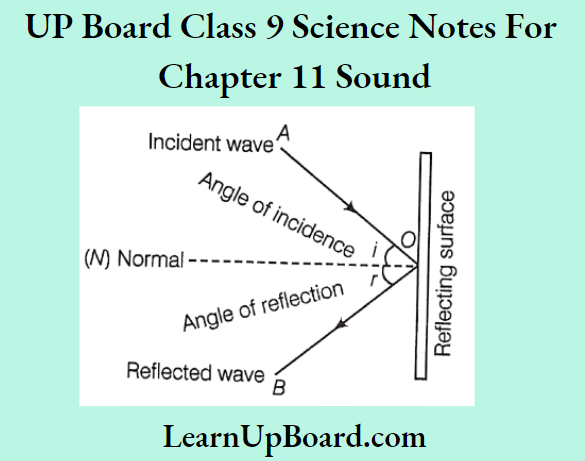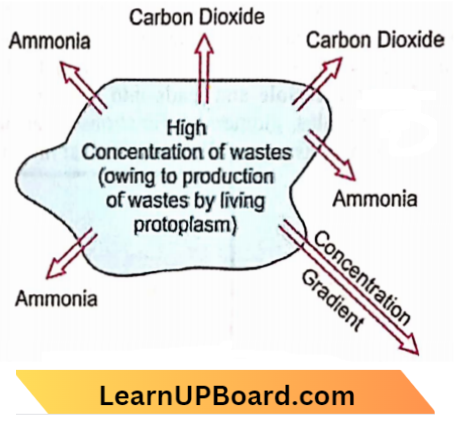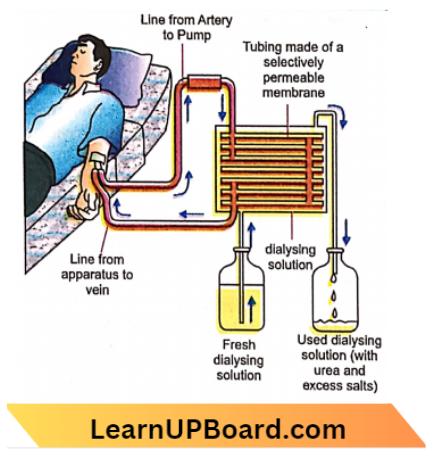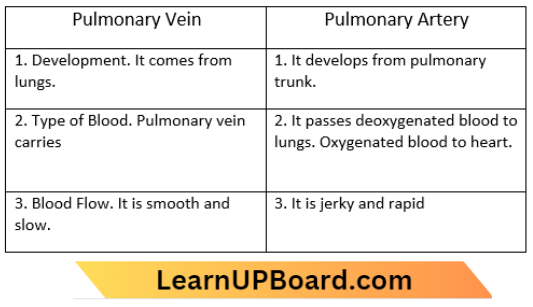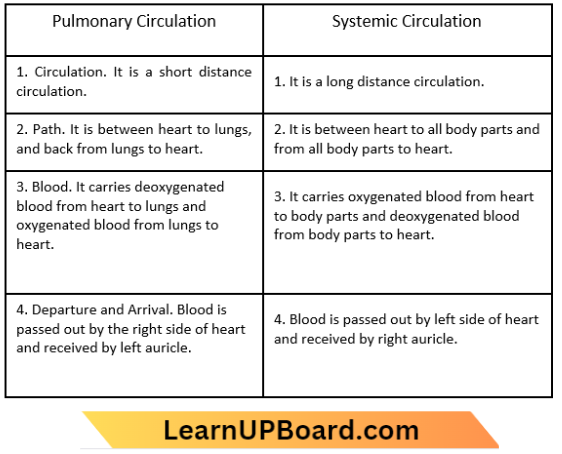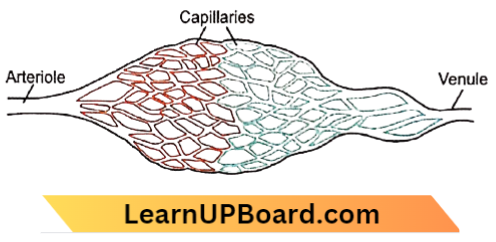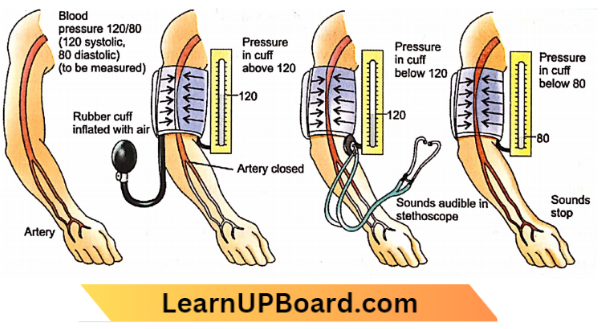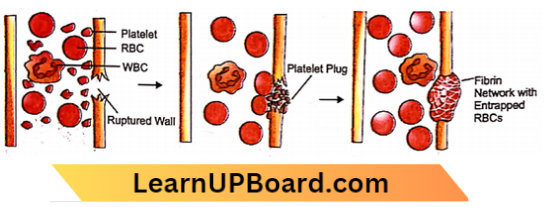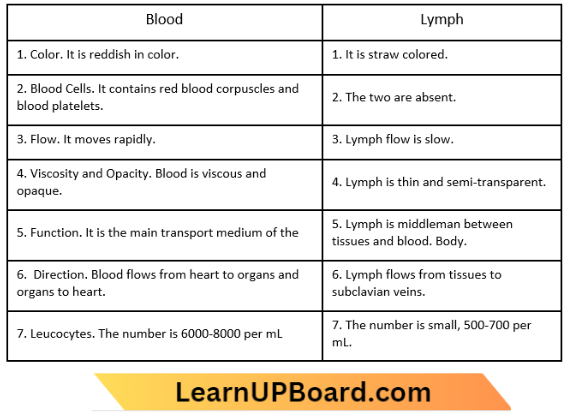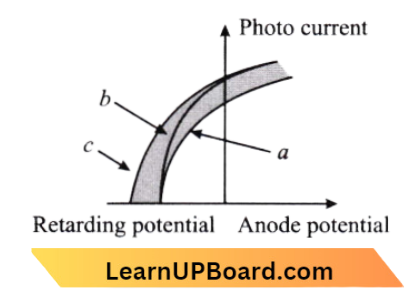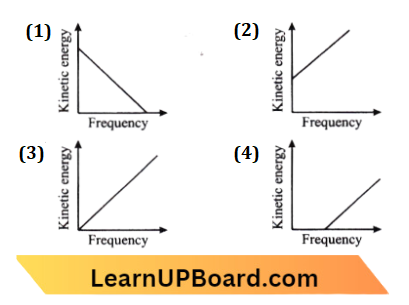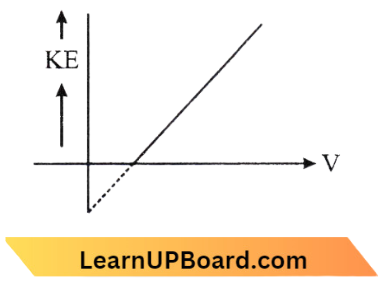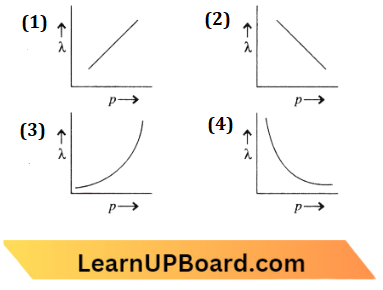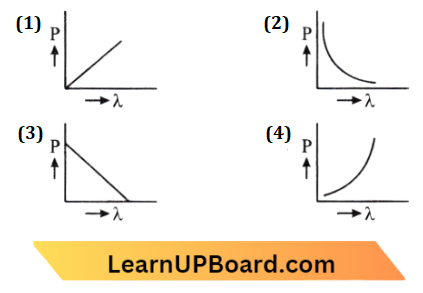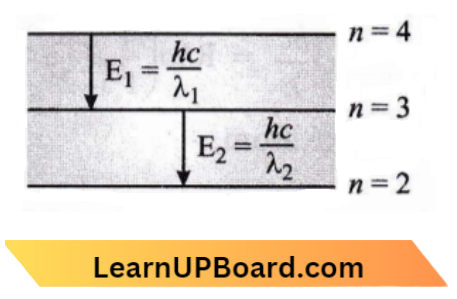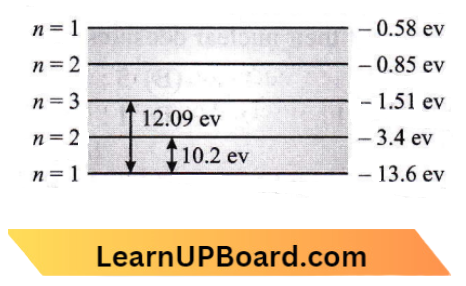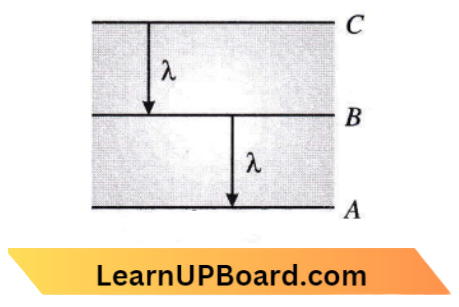UP Board Class 9 Science Notes For Chapter 7 Motion
- In everyday life, we observe several types of motions like vehicles moving on a road, flying birds, movement of needles of a watch, movement of blades of a fan, circulation of blood through veins and arteries, etc.
- Atom molecules, planets, stars and galaxies are all in motion. If a body changes its position concerning time and its surroundings, it is said to be in motion. Motion and rest are always relative but never absolute.
UP Board Class 9 Science Notes For Chapter 7 Various Terms Related To Motion
Position
The location of an object concerning a particular point is known as the position of the object. The particular point about which the position of the object is defined, is called reference point or origin.
Scalar and Vector Quantities
- Physical quantities with which we can associate only magnitude, i.e. numbers are called scalar quantities, For Example, mass, time, distance, speed, etc.
- Physical quantities with which we can associate magnitude, i.e. numbers as well as direction are called vector quantities, For Example, weight, displacement, velocity, etc.
Read and Learn More Class 9 Science Notes
Distance Definition
- The distance travelled by a body is the actual length of the path covered by it, irrespective of the direction in which the body travels. It is a scalar quantity. Its SI unit is metre, For Example, Consider the motion of an object moving along a straight path.
- Let the object start its motion from point O and move through points A, B, and C and reach upto point D.
- Then, the total distance covered by the object = actual length upto D of the path travelled
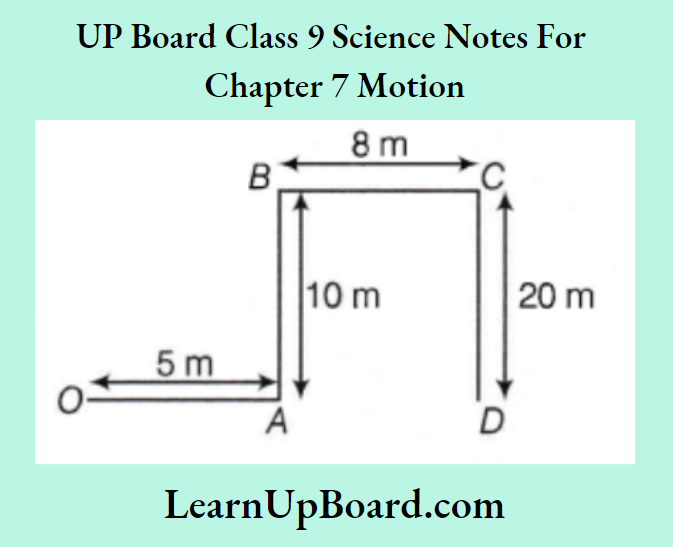
= OA + AB + BC + CD = 5m + 10m + 8m+20m = 43m
Displacement
- The displacement of an object is the change in the position of the object when it moves from a given position to another position. It is equal to the length of the shortest path measured in the direction from the initial position to the final position of the object. It is a vector quantity. Its SI unit is metre (m).
- Suppose an object starts to move from point O and reaches point B, passing through A.
- Here, the initial position of the object is O and the final position is B. So, displacement of the object = length of the shortest path between the initial position (O) and the final position (B).
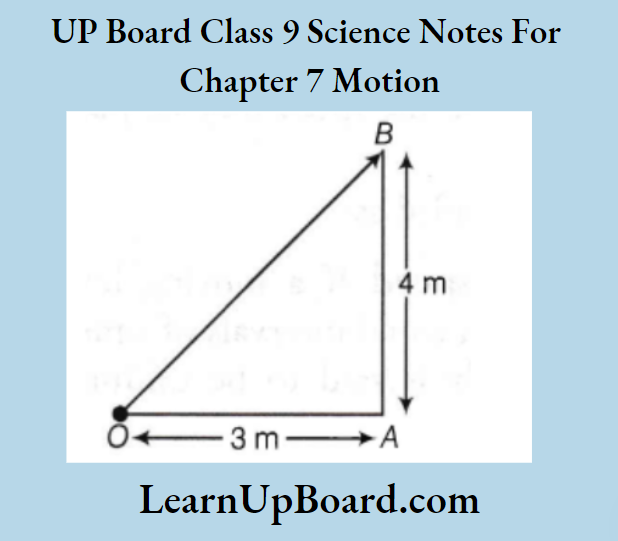
= OB = \(\sqrt{O A^2+A B^2}\) [from Pythagoras theorem] }
= \(\sqrt{(3)^2+(4)^2}\)
= \(\sqrt{9+16}=\sqrt{25}\)
= 5 m
But, distance in this case = length of actual path = OA + AB = 3 m +4 m = 7 m
Distance versus Displacement
1. Displacement of a moving object can never be greater than the distance travelled by it.
Displacement \(\leq\) Distance
∴ \(\frac{\text { Displacement }}{\text { Distance }} \leq 1\)
i.e. Ratio of displacement and distance is always less than or equal to 1.
2. If a body moves along a straight line (only in one direction), then distance and displacement will be equal.
3. Displacement of the object can be positive, negative or zero but distance can never be negative or zero.
Example 1. A Jogger jogs along one length and breadth of a rectangular park. If the dimensions of park are 150 m x 120 m, then find the distance travelled and displacement of the Jogger.
Answer:
Given
A Jogger jogs along one length and breadth of a rectangular park. If the dimensions of park are 150 m x 120 m
According to question,
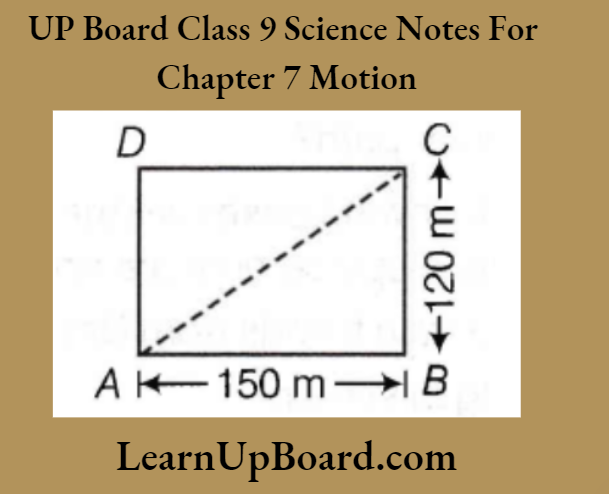
Length, l = 150 m, Breadth, b =120 m Distance travelled, s =?
Displacement of the Jogger = ?
Suppose, the Jogger starts from point A and after covering one breadth and one length reaches at point C.
Distance, 5 = Length of the total path covered = AB + BC s = 150 + 120 = 270 m
Displacement = Minimum distance between initial and final position = AC
From Pythagoras theorem, A C=\(\sqrt{(A B)^2+(B C)^2}\)
i.e. Displacement =\(\sqrt{(150)^2+(120)^2}\)=30 \(\sqrt{41} \mathrm{~m}\)
Thus, the Jogger travels a distance of 270 m and his displacement is 30 \(\sqrt{41} \mathrm{~m}\).
Example 2, A body moves in a circular path of radius 20 cm. If it completes two and half revolution along the circular path, then find the distance and displacement of the body.
Answer:
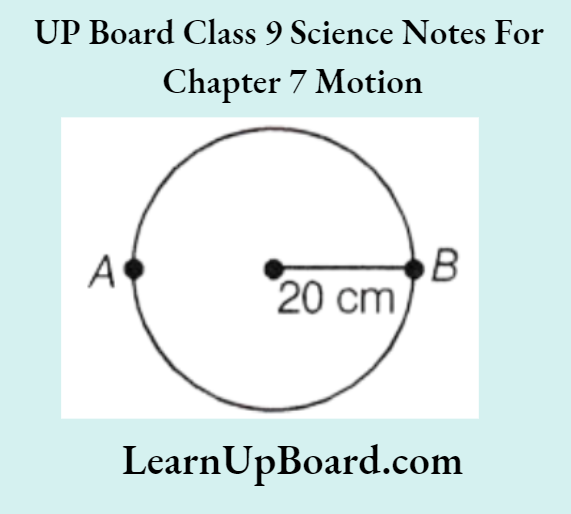
Given
A body moves in a circular path of radius 20 cm. If it completes two and half revolution along the circular path
According to question, body moves in a circular path of radius 20 cm. So, during one complete revolution the distance (d) moved by the body is equal to the circumference of the circular path, i.e. 2\(\pi r\). where, r = radius of circular path
So, for two and half revolution, body covers two complete revolutions, i.e. 2×2\(\pi r\) distance and half revolution, i.e. \(\frac{2 \pi r}{2}=\pi r\) distance.
Total distance (s) covered by the body = (2 x 2\(\pi r\)) + \(\pi\)r = 5\(\pi\)r
= 5 x 3.14 x 20
= 314 cm
Now, as we know displacement (d) is the straight line distance between the initial and final position of the body. So, after two and half revolutions, total displacement (d) of the body will be 2r, i.e. displacement (d) = 2×20 = 40 cm.
UP Board Class 9 Science Notes For Chapter 7 Uniform And Non-Uniform Motion
Uniform Motion Of A Body
- A body is said to have a uniform motion, if it travels equal distances in equal intervals of time, no matter how small these intervals may be. The distance travelled by an object in uniform motion increases linearly.
- For Example. If a car moving along a straight line path, covers equal distances in equal intervals of time, it is said to be in uniform motion.
Non-uniform Motion Of A Body
- A body is said to have a non-uniform motion, if it travels unequal distances in equal intervals of time, no matter how small these intervals may be.
- For Example, A car moving through a crowded market has non-uniform motion.
Rate of Motion
The ratio of distance travelled by an object to the time taken is called rate of motion. The various terms required to measure the rate of motion are as given below:
Speed
- Speed of an object is defined as the distance travelled by it per unit time.
- Speed or an object (v} = \(\frac{\text { Distance }(s)}{\text { Time }(t)}\)
- Speed is a scalar quantity. The SI unit of speed is metre per second (m/s). The distance travelled by an object is either positive or zero, so the speed may be positive or zero but never negative.
Speed can be classified as:
- Uniform speed If a moving body covers equal distances in equal intervals of time, then the speed of the body Is said to be uniform, i.e. constant speed.
- Non-uniform speed If a moving body covers unequal distances in equal intervals of time, then the speed of the body is said to be non-uniform, i.e. variable speed.
- Average speed It is defined as the ratio of the total distance travelled by a body to the total time taken. It is expressed as the Total distance travelled
- Average speed =\(\frac{\text { Total distance travelled }}{\text { Total time taken }}\)
- =\(\frac{s_1+s_2+s_3+\ldots}{t_1+t_2+t_3+\ldots}\)
- Instantaneous speed: The speed of an object at any particular instant of time or a particular point of its path is called the instantaneous speed of the object.
Example 3. The odometer of a bike reads 1600 km at the start of the trip and 2000 km at the end of the trip. If the bike took 16 h, calculate the average speed of the bike in km/h and m/s.
Answer:
Given
The odometer of a bike reads 1600 km at the start of the trip and 2000 km at the end of the trip. If the bike took 16 h,
Distance covered by bike, s = 2000 km -1600 km = 400 km
Time taken, t =16 h
Average speed \(v_{\mathrm{av}} =\frac{s}{t}\)
=\(\frac{400}{16}=25 \mathrm{~km} / \mathrm{h}\)
\(v_{\mathrm{av}} =25 \times \frac{5}{18}\)= 6.9 m/s
Therefore, the average speed of the bike is 6.9 m/s.
Example 4. An object travels 14 m and then another 16m in 2s. What is the average speed of an object?
Answer:
Given
An object travels 14 m and then another 16m in 2s
According to the question,
First distance, sx =14 m
According to the question,
First distance, \(s_1=14 \mathrm{~m}\)
Second distance, \(s_2=16 \mathrm{~m}\), Times, \(t_1=4 \mathrm{~s}, t_2=2 \mathrm{~s}\)
Average speed =\(\frac{\text { Total distance }}{\text { Total time }}=\frac{s_1+s_2}{t_1+t_2}\)
=\(\frac{14+16}{4+2}=\frac{30}{6}=5 \mathrm{~m} / \mathrm{s}\)
Therefore, the average speed of an object is 3 m/s.
Speed with Direction: Velocity
- Velocity of an object is defined as the displacement of the body per unit time. i.e. velocity is the speed of an object moving in a definite direction.
- It is expressed as \(\text { Velocity of an object }(v)=\frac{\text { Displacement }(d)}{{Time}(t)}\)
- Velocity is a vector quantity. The SI unit of velocity is metres per second (m/s). The velocity of an object can be positive, zero or negative. The velocity of an object can be changed by changing the object’s speed, the direction of motion or both.
Velocity can be classified as:
1. Uniform velocity If an object covers equal displacements in equal intervals of time without changing direction, then its velocity is known as uniform velocity, i.e. constant velocity.
2. Non-uniform velocity If an object covers unequal displacements in equal intervals of time, then its velocity is known as non-uniform velocity, i.e. variable velocity.
3. Average velocity It is defined as the ratio of the total displacement of the object to the total time taken.
It is expressed as \(v_{\text {av }}=\frac{\text { Total displacement }}{\text { Total time taken }}\)
If the velocity of an object changes at a uniform rate, then the average velocity,
⇒ \(\left(v_{\text {av }}\right)=\frac{{Initial} \text { velocity }(u)+\text { Final velocity }(v)}{2}\)
4. Instantaneous velocity The velocity of an object at a particular instant of time or at a particular point of its path is called its instantaneous velocity.
Note : (1) If a body is moving in a straight line, then the magnitude of its speed and velocity will be equal.
(2) Average speed of an object can never be zero but the average velocity of a moving object can be zero.
Example 5. Rajeev went from Delhi to Chandigarh and returned to Delhi on his motorbike. The odometer of that read 4200 km at the start of trip and 4460 km at the end of his trip. If Rajeev took 4 h 20 min to complete his trip, then find the average speed and average velocity in km/h as well as in m/s.
Answer:
Given
Rajeev went from Delhi to Chandigarh and returned to Delhi on his motorbike. The odometer of that read 4200 km at the start of trip and 4460 km at the end of his trip. If Rajeev took 4 h 20 min to complete his trip
As we know that, the total distance covered,
s = final reading of odometer – initial reading of odometer
= (4460 -4200) km = 260 km
Total time taken, t = 4 h 20 min = 4.33 h
Average speed =\(\frac{\text { Total distance covered }(s)}{\text { Total time taken }(t)}\)
=\(\frac{260 \mathrm{~km}}{4.33 \mathrm{~h}}=60 \mathrm{~km} / \mathrm{h} or \frac{60 \times 5}{18}=16.67 \mathrm{~m} / \mathrm{s}\)
Average velocity =\(\frac{\text { Total displacement }(d)}{\text { Total time taken }(t)}\)
= \(\frac{0}{4.33}=0 \mathrm{~m} / \mathrm{s} \text { or } 0 \mathrm{~km} / \mathrm{h}\)
Average speed of Rajeev is 16.67 m/s and average velocity is 0.
Rate of Change of Velocity: Acceleration
Acceleration is defined as the rate of change of velocity with respect to time.
Mathematically, it is expressed as \(\text { Acceleration }(a)=\frac{\text { Change in velocity }(\Delta v)}{\text { Change in time }(\Delta t)}\)
If in a given time interval t, the velocity of a body changes from u to v, then acceleration a is expressed as
a=\(\frac{{Final} \text { velocity }(v)-{Initial}{velocity}(u)}{\text { time interval }(t)}\)
a=\(\frac{v-u}{t}\)
This kind of motion is known as accelerated motion. The SI unit of acceleration is \(\mathrm{m} / \mathrm{s}^2\). It is a vector quantity.
The acceleration is taken to be positive, if it is in the direction of velocity, negative if it is opposite to the direction of velocity and zero when it is moving with a constant velocity.
Note: If velocity of an object decreases with time, then it is said to have negative acceleration. Negative acceleration is also called deceleration or retardation.
Acceleration can be classified as:
(1) Uniform acceleration If an object travels in a straight line and its velocity increases or decreases by equal amounts in equal intervals of time, then the object is said to be in a uniform acceleration.
For Example:
- The motion of a freely falling body.
- The motion of a ball rolling down on an inclined plane.
(2) Non-uniform acceleration If the velocity of an object increases or decreases by unequal amounts in equal intervals of time, then the object is said to be in a non-uniform acceleration.
For Example:
- The movement of a car on a crowded city road.
- The motion of the train leaving or entering the platform.
Example 6. Starting from a stationary position, a car attains a velocity of 5 m/s in 20 s. Then, the driver of the car applies a brake such that the velocity of the car comes down to 3 m/s in the next 6 s. Calculate the acceleration of the car in both the cases.
Answer:
Given
Starting from a stationary position, a car attains a velocity of 5 m/s in 20 s. Then, the driver of the car applies a brake such that the velocity of the car comes down to 3 m/s in the next 6 s.
Case 1 Initial velocity of the car, u = 0 it starts from stationary position]
Final velocity, v = 5 m/s, Time taken, t = 20 s .
a=\(\frac{v-u}{t}=\frac{5-0}{20}=0.25 \mathrm{~m} / \mathrm{s}^2\)
Case 2 Initial velocity, u=5 m/s
Final velocity, v=3m/s, Time taken, t=6 s
Acceleration =\(\frac{\text { Change in velocity }}{\text { Time }}\)
= \(\frac{\text { Final velocity }- \text { Initial velocity }}{\text { Time }}=\frac{v-u}{t}\)
a =\(\frac{3-5}{6}=-0.33 \mathrm{~m} / \mathrm{s}^2\)
Thus, the acceleration in both cases are 0.25 \(\mathrm{~m} / \mathrm{s}^2\) and -0.33 \(\mathrm{~m} / \mathrm{s}^2\).
UP Board Class 9 Science Notes For Chapter 7 Graphical Representation Of Motion
To describe the motion of an object, we can use line graphs.
In this case, line graphs show the dependence of one physical quantity, such as distance or velocity, on another quantity, such as time.
Note: For a graphical description of a motion, it is convenient to take time along the A-axis, whereas distance, speed or velocity is taken along the Y-axis.
Types of Graph
There are two main types of graphs which we will be studying as given below:
1. Distance-Time Graph
The change in the position of an object with time can be represented on the distance-time graph adopting a convenient scale of choice.
To draw a distance-time graph, time is plotted along the X-axis distance of the body is plotted along the T-axis.
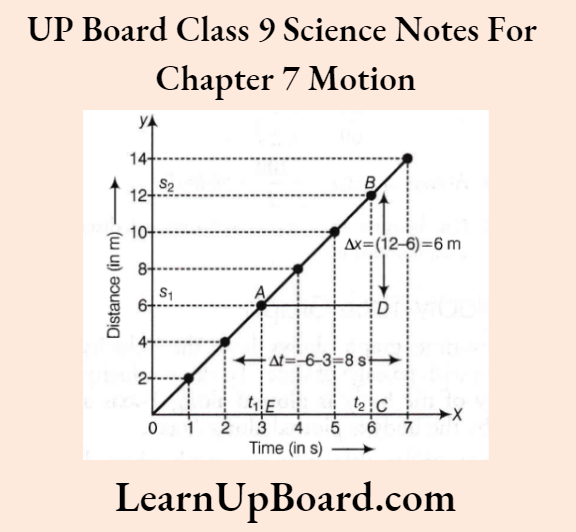
In this case, the slope of the distance-time graph is equal to the speed of the object.
Distance-time graphs under various conditions are explained below:
(1) Distance-Time Graph for Uniform Motion
If an object travels equal distances in equal intervals of time, then it moves with uniform speed.
For uniform speed, a graph of distance travelled against time is a straight line as shown:
Distance-time graph for uniform motion
Interpretation
From the graph, it is clear that in equal intervals of time, i.e. 2s, the object covers an equal distance of 4m, so the motion is uniform and the graph is a straight line.
Calculation of speed To calculate the speed of the object from a distance-time graph, choose any two points say A and B on a straight line. From points A and B, draw perpendiculars AE and BC respectively, on the time axis. Now, draw a perpendicular AD on BC. The distance travelled by the object from point A to B is given by
⇒ \(\Delta x=B C-C D=s_2-s_1\)
Time taken by the object to cover this distance
= \(\Delta t=t_2-t_1\) .
Speed, v=\(\Delta x / \Delta t=\left(s_2-s_1\right) /\left(t_2-t_1\right)\)
i.e. \(\Delta x / \Delta t\)= Slope of distance-time graph.
(2) Distance-Time Graph for Non-uniform Motion
- If a body travels unequal distances in equal intervals of time, then the motion of the body is known as non-uniform motion. Non-uniform motion is of two types such as:
- When the speed of the body increases with the passage of time, then the distance-time graph will be a curve with a positive slope as shown alongside:
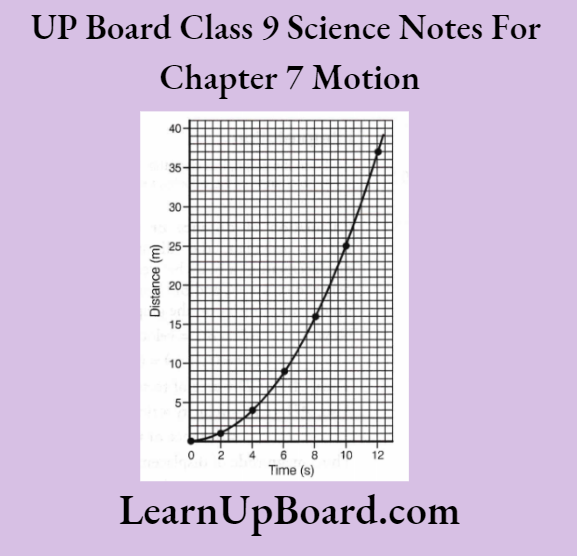
Interpretation
- From the graph, it is clear that in equal intervals of time of two seconds, the body is covering unequal distances and this distance goes on increasing. That means, with the passage of time, the body is covering more and more distance in equal time, i.e. the speed of the body is increasing.
- When the speed of the body decreases with the passage of time, then the distance-time graph will be a curve with a negative slope
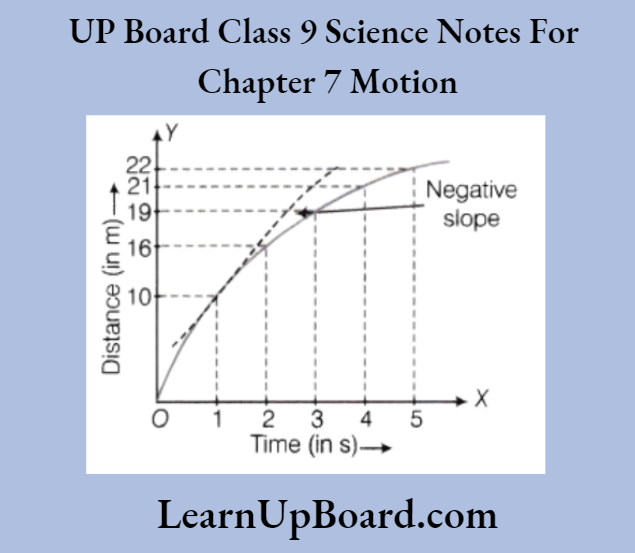
Interpretation
From the graph, it is clear that in equal intervals of time of one second, the body is covering unequal distances and this distance goes on decreasing. That means, with the passage of time, the body is covering lesser and lesser distance in equal time, i.e. the speed of the body is decreasing.
The graph below shows the positions of a body at different times. Calculate the speed of the body as it moves from (1) A to B, (2) B to C and (3) C to D.
(1) For the motion from points to B, time taken, t = 5 – 2 = 3 s Distance covered = 3 — 0 = 3 m
Speed during the motion from point to B
= \(\frac{\text { Distance }}{\text { Time }}\)
= \(\frac{3}{3}=1 \mathrm{~m} / \mathrm{s}\)
(2) For the motion from point B to C, time is taken, t-7 — 5 = 2 s
Distance covered = 3 – 3 = 0 m [Body does not change its position from point B to C]
Speed during the motion from point B to C _ Distance Time
=\(\frac{\text { Distance }}{\text { Time }}\)
=\(\frac{0}{2}\)=0
(3) For the motion from point C to D,
time taken, r=10-7=3s
Distance covered = 8 – 3 = 3 m
Speed during the motion from point C to D
=\(\frac{\text { Distance }}{\text { Time }}\)
=\(\frac{5}{3}\)
Example 7. The following table gives the data about motion of a car:
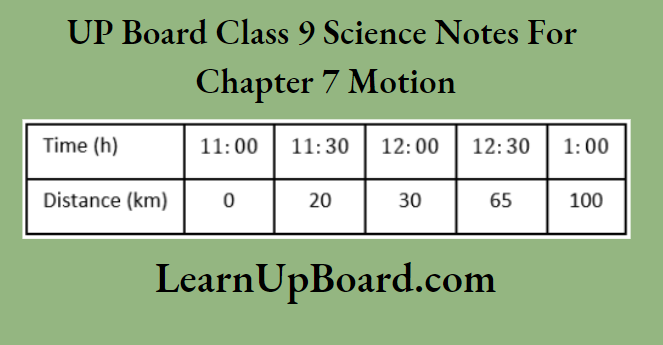
Plot the graph and
- find the speed of the car between 12:00 h and 12:30 h,
- what is the average speed of the car?
- Is the car’s motion an example of uniform motion? Justify.
Answer:
(1) Speed of the car between 12: 00h and 12: 30 h is given by
v=\(\frac{65-30}{\frac{30}{60}}=\frac{35}{\left(\frac{1}{2}\right)}=70 \mathrm{~km} / \mathrm{h}\)
(2) Average speed, \(v_{\mathrm{av}}=\frac{100}{2}=50 \mathrm{~km} / \mathrm{h}\)
(3) No, because the car covered unequal distances in equal intervals of time.
2. Velocity-Time Graph
The velocity-time graph shows how the velocity of a body changes with the passage of time. To draw a velocity-time graph, the velocity of the body is plotted along the T-axis and the time taken by the body is plotted along X-axis.
The area under the velocity-time graph gives the displacement. Velocity-time graphs under various conditions are explained as below:
(1) Velocity-Time Graph for a Body Moving with Constant Velocity
When a body moves with constant velocity, i.e. its motion is uniform, then its velocity does not change with time.
The graph will be a straight line parallel to the time axis.
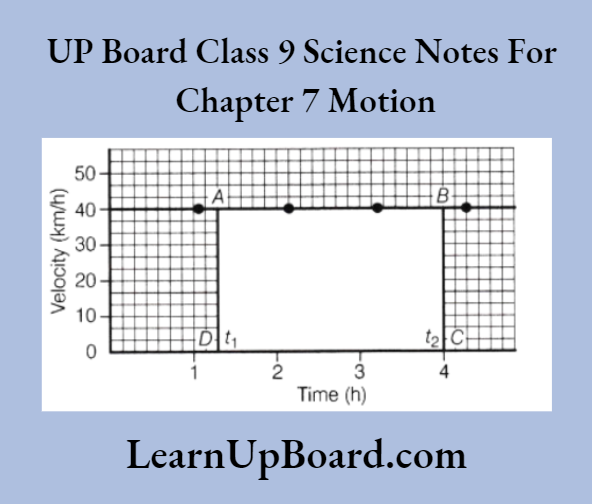
Interpretation
From the graph, it is clear that with time, there is no change in the velocity, i.e. the body is moving with constant velocity.
Calculation of distance or magnitude of displacement
Let us calculate the distance or magnitude of the displacement of a body between time tx and time t2 • Draw perpendiculars A Cand BD from the points corresponding to time tx and time t2 on the graph.
Now, AD – BC = velocity of the body
CD =(t2 -t1) = time interval
Thus, AD x CD = area of rectangle ABCD
Also, AD x CD = velocity x time
= distance or magnitude of displacement Thus, the magnitude of displacement
= area under velocity-time graph
(2) Velocity-Time Graph for Uniform Accelerated Motion
In uniform accelerated motion, the velocity changes be equal amounts in equal intervals of time. In this case, the velocity-time graph is a straight line passing through the origin.
Interpretation
The nature of the graph shows that velocity changes by equal amounts in equal intervals of time. In equal intervals of time, i. e. 10 s, the change in velocity is 18 m/s, which remains the same, which means the acceleration of the body is constant. Thus, for all uniformly accelerated motion, the velocity-time graph is a straight line.
Calculation of distance or magnitude of displacement To determine the distance moved by the car from its velocity-time graph. The area under the velocity-time graph gives the distance (magnitude of displacement) moved by the car in a given interval of time. Therefore, S=area of ABCDE
=Area of the rectangle ABCD area of triangle ADE
∴ \(A B \times B C+\frac{1}{2}(A D \times D E)\)
(3) Velocity-Time Graph for Non-uniform Accelerated Motion
A velocity-time graph for non-uniform accelerated motion is given below:
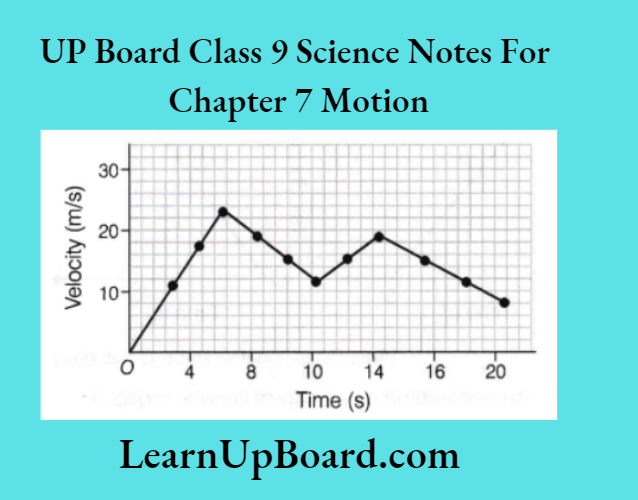
It shows that the velocity of a body (or object) varies non-uniformly with time.
Example 8. The velocity-time graph of an ascending passenger lift is shown in the figure below. What is the acceleration of the lift?
- During the first two seconds?
- Between 2nd and 10th second?
- During the last two seconds?
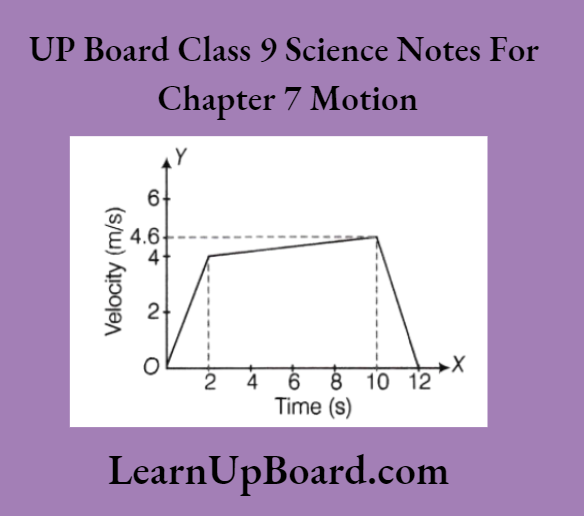
Answer:
Case 1. \(\Delta v=4-0=4 \mathrm{~m} / \mathrm{s}, \Delta t=2-0=2 \mathrm{~s}, a_1\)=?
⇒ \(a_1=\frac{\Delta v}{\Delta t}=\frac{4}{2}=2 \mathrm{~m} / \mathrm{s}^2\)
Case 2. \(\Delta v=4.6-4=0.6 \mathrm{~m} / \mathrm{s}, \Delta t=10-2=8 \mathrm{~s}, a_2\)= ?
⇒ \(a_2=\frac{\Delta v}{\Delta t}=\frac{0.6}{8}=0.075 \mathrm{~m} / \mathrm{s}^2\)
Case 3. \(\Delta v=0-4.6=-4.6 \mathrm{~m} / \mathrm{s}, \Delta t=12-10=2 \mathrm{~s}, a_3\)=?
⇒ \(a_3=\frac{\Delta v}{\Delta t}=\frac{-4.6}{2}=-2.3 \mathrm{~m} / \mathrm{s}^2\)
A negative sign shows retardation.
Example 9. A body moves with a velocity of 2 m/s for 5 s, then its velocity increases uniformly to 10 m/s in the next 5 s. Thereafter, its velocity begins to decrease at a uniform rate until it comes to rest after 5 seconds.
- Plot a velocity-time graph for the motion of the body.
- From the graph, find the total distance covered by the body after 2 s and 12 s.
Answer:
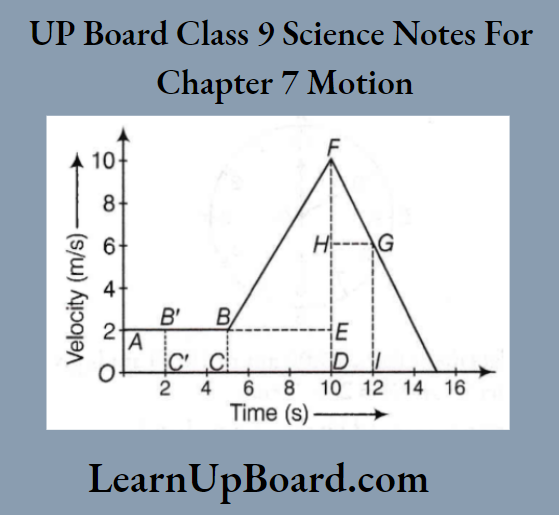
As we know, the distance moved by the body after 2 s = area OAB’C’ = 2 m/s x 2 s = 4 m.
Again distance covered by the body after 12 s = Area OAED + Area of ABEF
=2 \(\mathrm{~m} / \mathrm{s} \times 10 \mathrm{~s}+\frac{1}{2} \times 5 \mathrm{~s} \times 8 \mathrm{~m} / \mathrm{s}+6 \mathrm{~m} / \mathrm{s} \times 2 \mathrm{~s} +\frac{1}{2} \times 2 \mathrm{~s} \times 4 \mathrm{~m} / \mathrm{s}\)
= 20m + 20m+12m + 4m = 56m
UP Board Class 9 Science Notes For Chapter 7 Uniform Circular Motion
If an object moves in a circular path with uniform speed, then its motion is called uniform circular motion.
When an object moves along a circular path, its direction of motion keeps changing continuously. The velocity changes due to continuous change in direction and thus motion along a circular path is said to be accelerated.
When a body takes one round of a circular path, then it travels a distance equal to its circumference which is \(2 \pi\) r, where r is the die radius of the circular path.
Then, the speed of the body moving in a circular path, v =2 \(\pi r / t\), where t is the time taken for one round of circular path and K is constant having a value of 22/7.
Some of the examples of uniform circular motion are as follows:
A piece of stone tied to a thread and rotated in a circle with a uniform speed.
The motion of blades of an electric fan around the axle.
The motion of the moon and the earth.
A satellite in a circular orbit around the earth.
A car is moving on a circular path with constant speed.
Example 10. The minute hand of a wall clock is 10 cm long. Find its displacement and the distance covered from 10:00 am to 10:30 am.
Answer:
Given, the length of the minute hand, l = 10 cm
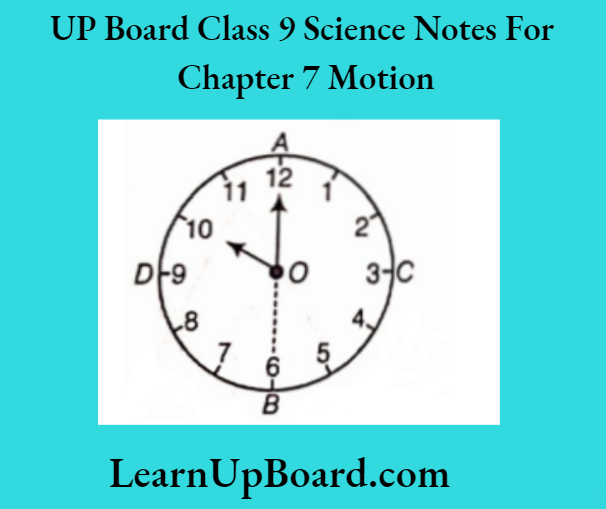
Displacement from 10:00 am to 10:30 am is given by diameter AOB =21 = 20 cm
Total distance covered by the minute hand
ACB = \(\pi l=\frac{22}{7} \times 10 \mathrm{~cm}=\frac{220}{7}=31.43 \mathrm{~cm}\)
The displacement of the minute hand is 20 cm and the distance is 31.43 cm.
UP Board Class 9 Science Notes For Chapter 7 Activity 1
Objective: To measure the distance covered and magnitude of displacement
Materials Required: A metre scale and a long rope.
Procedure
1. Take a metre scale and a long rope.
2. Walk from one corner of a basketball court to its opposite corner along its sides.
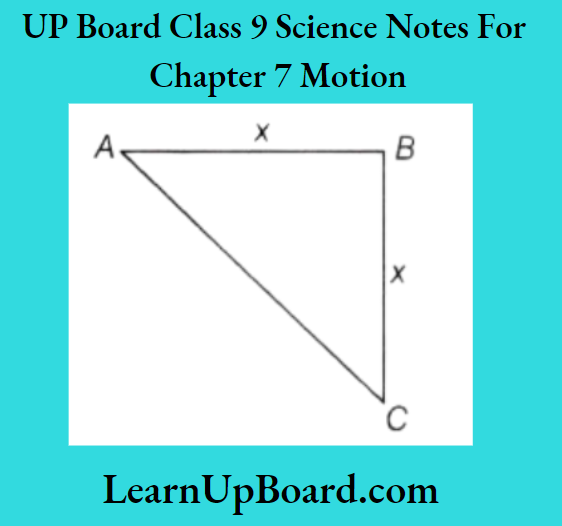
3. Measure the distance covered by you and the magnitude of the displacement.
4. Note the difference between the two in this case.
Discussion/Conclusion
The distance covered while walking from one comer of the basketball court to its opposite comer along its sides is more, i.e. A to B and B to C is 2x.
The magnitude of the displacement is from A to Q which is less than the distance travelled.
Question 1. What do you understand by the displacement of an object?
Answer:
The displacement of an object is the shortest distance between the initial and final positions of the moving object.
Question 2. Which is least in this activity distance or displacement?
Answer:
Displacement is the least in this activity.
Question 3. Can displacement be negative?
Answer:
Yes, displacement can be negative.
UP Board Class 9 Science Notes For Chapter 7 Activity 2
Objective: To find the magnitude of the displacement using a road map.
Materials Required: Road map of India.
Procedure
1. A car fitted with an odometer is driven from Bhubaneshwar to New Delhi. The difference between the final reading and the initial reading of the odometer is 1850 km.
2. Find the magnitude of the displacement between Bhubaneshwar and New Delhi by using the road map of India.
Discussion Or Conclusion
We find the aerial distance from the atlas. Then, we measure the straight distance between Bhubaneshwar to New Delhi and convert the. measurement as given in the map.
Question 1. Name the device that is used to measure distance in a vehicle.
Answer:
An odometer is a device used to measure distance in a vehicle.
Question 2. What is the difference between the final reading and the initial reading of the odometer?
Answer:
The difference between the final reading and the initial reading of the odometer is called displacement.
Question 3. How do we find the displacement using a road map?
Answer:
We find the displacement by calculating aerial distance using an atlas map.
Activity 3
Objective: State whether the motion of the objects is uniform or non-uniform.
Materials Required: Given data table.
Procedure
- The data regarding the motion of two different objects A and B are given in the table.
- Examine them carefully and state whether the motion of the objects is uniform or non-uniform.
- Distances travelled by objects A and B at different times are as given below:
- Time Distance travelled by object A (in m) Distance travelled by object B (in m)
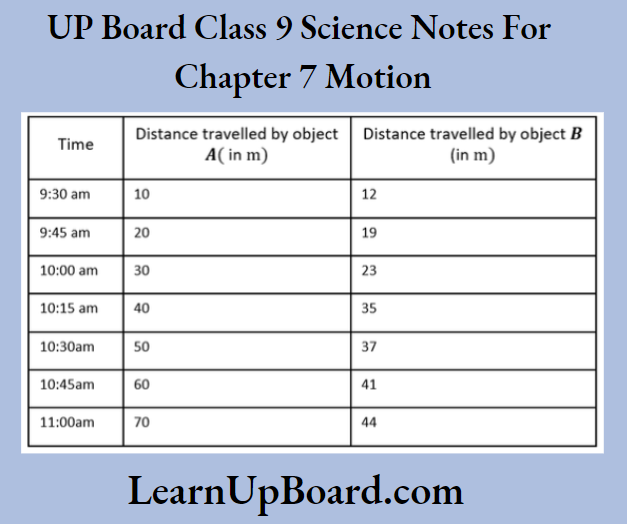
Discussion Or Conclusion
- Object A travels equal distances in equal intervals of time. Hence, object A shows uniform motion.
- Object B travels unequal distances in equal intervals of time. Hence, object B is showing non-uniform motion.
Question 1. How will you identify the non-uniform motion of an object?
Answer:
An object is said to be in non-uniform motion if it covers unequal distances in equal intervals of time.
Question 2. What is the path of uniform motion?
Answer:
The path of uniform motion is a straight line.
Question 3. Give two examples of non-uniform motion.
Answer:
- A racing horse
- Throwing a softball
UP Board Class 9 Science Notes For Chapter 7 Activity 4
Objective: To show that light travels faster than sound.
Materials Required: Digital wristwatch or a stopwatch.
Data Required: Speed of sound in air = 346 m/s Speed of light = 3 x 108 m/s
Procedure
- At a time when it is cloudy, there may be frequent thunder and lightning. The sound of thunder takes some time to reach you after you see the lightning.
- Can you answer why this happens?
- Measure this time interval using a digital wristwatch or a stopwatch.
- Calculate the distance of the nearest point of lightning.
Discussion Or Conclusion
- Lightening travels with the speed of light, i.e. 3 x 108 m/s and thunder travels with the speed of sound in air, i.e. 346 m/s. That is why the sound of thunder reaches us some time later than we see the lightning. Using a digital wristwatch or a stopwatch, we measure this time interval.
- Let us consider 2 s. Thus, distance = Speed x Time = 346 x 2 =692 m Since the speed of light is almost infinite and takes almost no time to reach us. The measured time interval is the time taken by the sound of thunder to reach us. Thus, light travels much faster than sound.
Question 1. Name the instrument used to measure time intervals.
Answer:
A digital wristwatch/stopwatch is used to measure time intervals.
Question 2. At what speed does the lightning travel?
Answer:
Lightening travels with the speed of light, i.e. 3 x108 m/s.
Question 3. Why do we see lightning first during thunderstorms?
Answer:
We see lightning first because light travels faster than sound.
UP Board Class 9 Science Notes For Chapter 7 Activity 5
Objective: To identify a range of motions.
Procedure
In your everyday life, you come across a range of motions in which
- acceleration is in the direction of motion.
- acceleration is against the direction of motion.
- acceleration is uniform.
- acceleration is non-uniform.
Can you identify one example of each of the above types of motion?
Discussion Or Conclusion
- When the speed of a car on the road is increasing, then the acceleration of the car is in the direction of motion.
- When we apply brakes, the speed of the car is decreasing. The acceleration produced in the car is against the direction of motion.
- When the body is falling freely under the action of gravity, it has a uniform acceleration, i.e. 9.8 m/s (speed of the falling body is increasing at a constant rate.)
- When a car is passing through city limits on a highway, its acceleration/retardation is non-uniform depending on traffic congestion.
Question 1. Name the instrument used to measure time intervals.
Answer:
A digital wristwatch/stopwatch is used to measure time intervals.
Question 2. At what speed does the lightning travel?
Answer:
Lightening travels with the speed of light, i.e. 3 x108 m/s.
Question 3. Why do we see lightning first during thunderstorms?
Answer:
We see lightning first because light travels faster than sound.
UP Board Class 9 Science Notes For Chapter 7 Activity 5
Objective: To identify a range of motions.
Procedure:
In your everyday life, you come across a range of motions in which
- Acceleration is in the direction of motion.
- Acceleration is against the direction of motion.
- Acceleration is uniform.
- Acceleration is non-uniform.
Discussion Or Conclusion
- When the speed of a car on the road is increasing, then the acceleration of the car is in the direction of motion.
- When we apply brakes, the speed of the car is decreasing. The acceleration produced in the car is against the direction of motion.
- When the body is falling freely under the action of gravity, it has a uniform acceleration, i.e. 9.8 m/s (speed of the falling body is increasing at a constant rate.)
- When a car is passing through city limits on a highway, its acceleration/retardation is non-uniform depending on traffic congestion.
UP Board Class 9 Science Notes For Chapter 7 Activity 6
Objective: To plot and interpret the distance-time graph.
Materials Required: (1) Graph paper (2) Data given in the table
Procedure
- Study the times of arrival and departure of a train at three stations A, B and C and the distance of stations B and C from station A as given in the table.
- Plot and interpret the distance-time graph for the train assuming that its motion between any two stations is uniform.Station Distance from A (km) Time of arrival (h) Time of departure (h)

Discussion Or Conclusion
- The distance-time graph for the train is shown below. From 8:00 am to 8:15 am, the train is standing on station A. From 8:15 am to 11:15 am, the train moves with uniform speed and reaches station B at a distance of 120 km from A.
- From 11:15 am to 11:30 am, the train is at rest at station B. From 11:30 am to 13:00 pm, the train moves uniformly from station B to station C covering a distance of 60 km (180 -120) and finally halts at point C.
- Thus, when motion is uniform, the distance-time graph is a straight line and the slope of this straight line represents the velocity of the body.
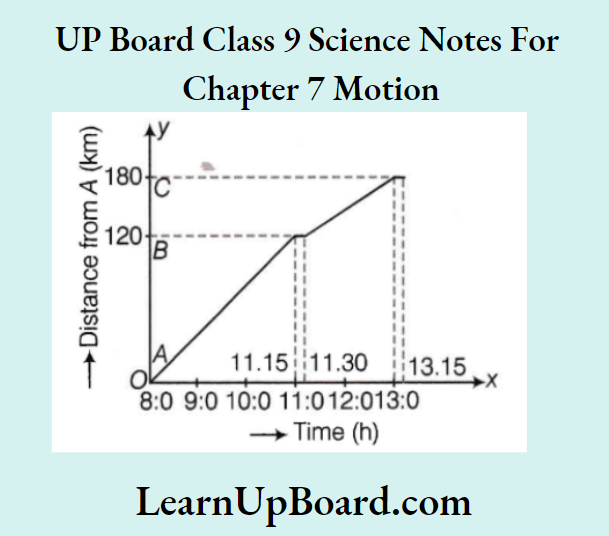
Question 1. While plotting a distance-time graph, why do we plot time on the x-axis?
Answer:
While plotting a distance-time graph, we should plot time on the x-axis as all the independent quantities are plotted on the x-axis.
Question 2. What does the slope of the distance-time graph represent?
Answer:
The slope of the distance-time graph represents the velocity of the body.
Question 3. What is the geometrical shape of the distance-time graph?
Answer:
The geometrical shape of the distance-time graph is a straight line.
UP Board Class 9 Science Notes For Chapter 7 Activity 7
Objective: To plot distance-time graph on the same scale and interpret.
Materials Required: (1) Graph paper (2) Data given in the table
Procedure
- Feroz and his sister Sania go to school on their bicycles. Both of them start at the same time from their home but take different times to reach the school although they follow the same route. The table shows the distance travelled by them at different times.
- Plot the distance-time graph for their motions on the same scale and interpret.
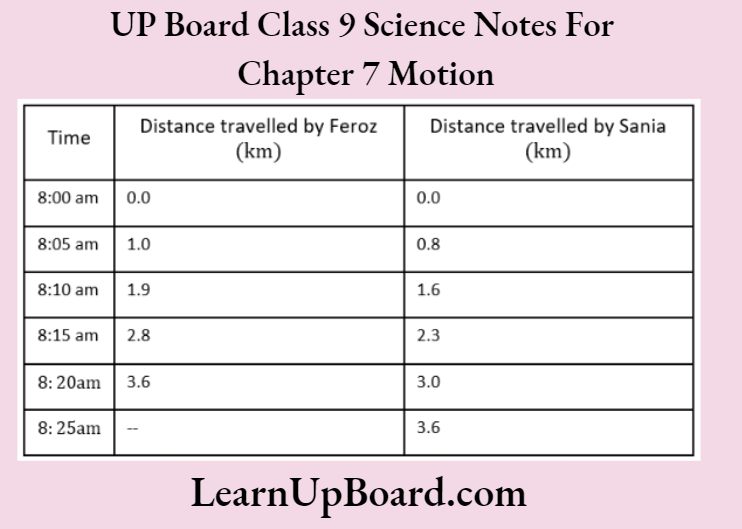
Discussion Or Conclusion
- The distance-time graph of both Feroz and Sania shows we have taken time on the x-axis and distance along the y-axis choosing a suitable scale.
- The distance-time graph of Feroz lies above the distance-time graph of Sania.
- This shows that Feroz is moving faster than Sania. However, speed is non-uniform.
Question 1. Which one of them is moving faster?
Answer:
Feroz is moving faster than Sania.
Question 2. What is the nature of motion?
Answer:
The nature of motion is non-uniform.
Question 3. While plotting a distance-time graph, what will you choose on the X-axis?
Answer:
We will choose distance on the y-axis.
UP Board Class 9 Science Notes For Chapter 7 Activity 8
Objective: To describe a circular path with constant speed.
Materials Required: (1) Piece of thread (2) Stone
Procedure:
- Take a piece of thread and tie a small piece of stone at one of its ends. Move the stone to describe a circular path with constant speed by holding the thread at the other end.
- Now, let the stone go by releasing the thread.
- Can you tell the direction in which the stone moves after it is released?
- By repeating the activity a few times and releasing the stone at different positions of the circular path, check whether the direction in which the stone moves remains the same or not.
Discussion Or Conclusion
- As soon as the stone is released, it moves along the tangent to the circular path at that moment.
- By releasing the stone at different positions of the circular path, we will find the direction in which the stone moves is always different, but it is along the tangent to the circular path at that instant.
- The stone is moving along a circular path due to the centripetal force provided by the pull of our hand on the stone.
- A stone describing a circular path with a . velocity of constant magnitude
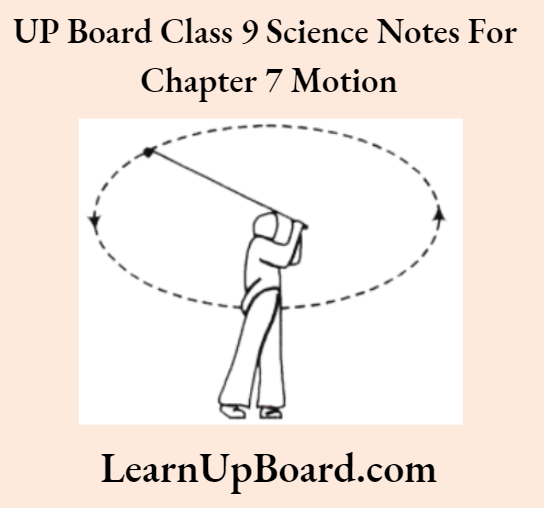
Question 1. Which force is required to change the direction in a circular motion?
Answer:
Centripetal force is required to change the direction.
Question 2. What is the direction of the stone which is released?
Answer:
The direction is tangential to the circular path.
Question 3. What is uniform circular motion known as?
Answer:
Uniform circular motion is known as accelerated motion.
UP Board Class 9 Science Notes For Chapter 7 Motion Question And Answers
Question 1. An object has moved through a distance. Can it have zero displacement? If yes, support your answer with an example.
Answer:
Yes, the displacement can be zero even, if the object has moved through a distance, e.g. a boy starts from his home to market and comes back. He has covered a distance but his displacement is zero.
Question 2. A farmer moves along the boundary of a square field of side 10 m in 40 s. What will be the magnitude of displacement of the farmer at the end of 2 min 20 s from his initial position?
Answer:
The farmer takes 40 s to move along the boundary of the square field, i.e. after 40 the farmer is again at his initial position, so his displacement is zero.
Time is given = 2 min 20 s = (2 x 60 + 20) s = 140 s Displacement of farmer after 2 min 20 s, i.e. after 140 s = Displacement after (3 x 40 + 20) s = 0 + displacement after 20 s [v after each 40 s displacement is zero]
The farmer completes one round in 40 s, so he will complete 1/2 round in 20 s, i.e. after the 20s the final position of a farmer is C.
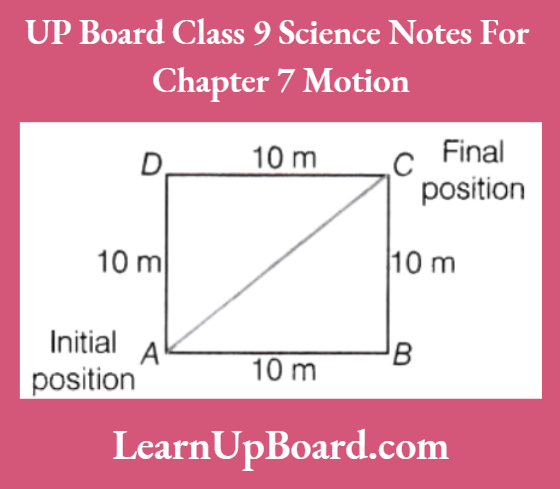
Displacement Of Farmer,
AC =\(\sqrt{A B^2+B C^2}\)
= \(\sqrt{10^2+10^2}\)
=10 \(\sqrt{2}=10 \times\) 1.414
=14.14 m
Question 3. Which of the following is true for displacement?
- It cannot be zero.
- Its magnitude is greater than the distance travelled by the object.
Answer:
- The displacement can be zero, so the first statement is false.
- The magnitude of displacement can never be greater than the distance travelled by the object. So, the second statement is also false.
Question 4. Distinguish between speed and velocity.
Answer:
Differences between speed and velocity are as given below:
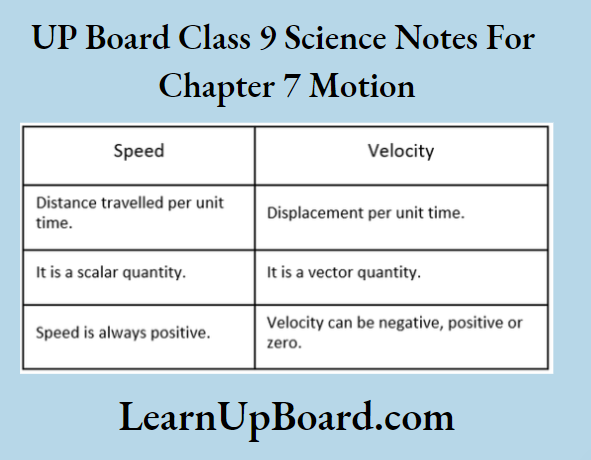
Question 5. Under what condition(s) is the magnitude of the average velocity of an object equal to its average speed?
Answer:
When the object travels in one direction along a straight line path then its average velocity will be equal to the average speed.
Question 6. What does the odometer of an automobile measure?
Answer:
It measures the distance travelled by an automobile.
Question 7. What does the path of an object look like when it is in a uniform motion?
Answer:
An object having uniform motion has a straight line path.
Question 8. During an experiment, a signal from a spaceship reached the ground station in five minutes. What was the distance of the spaceship from the ground station? The signal travels at the speed of light, i.e. 3 x 108 m/s.
Answer:
Given, speed of signal = 3 x 108 m/s
Time taken by the signal in reaching the earth = 5 min = 5 x 60 = 300s
Distance of spaceship from ground station
= Distance travelled by the signal in 5 min
= Speed x Time = 3 x 108 x 300
= 9 x 1010m
Question 9. When will you say a body is in (1) uniform acceleration? (2) non-uniform acceleration?
Answer:
- A body is in uniform acceleration if it travels in a straight path when its velocity increases or decreases by an equal amount in equal time intervals.
- A body is in non-uniform acceleration, if it travels in a straight path when its velocity increases or decreases by unequal amount in equal time intervals.
Question 10. A bus decreases its speed from 80 km/h to 60 km/h in 5 s. Find the acceleration of the bus.
Answer:
Given, the initial speed of the bus,
u=80 \(\mathrm{~km} / \mathrm{h}=80 \times \frac{5}{18}=22.22 \mathrm{~m} / \mathrm{s}\)
The final speed of the bus,
v=60 \(\mathrm{~km} / \mathrm{h}=60 \times \frac{5}{18}=16.67 \mathrm{~m} / \mathrm{s}\)
Time taken to decrease the speed, t=5 s
Acceleration of the bus,
a =\(\frac{v-u}{t}\)
= \(\frac{16.67-22.22}{5}\)
=-1.11 \(\mathrm{~m} / \mathrm{s}^2\)
The negative sign of acceleration indicates that the velocity of the bus is decreasing, i.e. the bus retards.
Question 11. A train starting from a railway station and moving with uniform acceleration attains a speed of 40 km/h in 10 min. Find its acceleration.
Answer:
The initial velocity of the train, u = 0
Final velocity of train, v=40 \(\mathrm{~km} / \mathrm{h}=40 \times \frac{5}{18}\)
=11.11 m/s
Time taken, t=10 \(\mathrm{~min}=10 \times 60=600 \mathrm{~s}\)
Acceleration, a=\(\frac{v-u}{t}\)
= \(\frac{11.11-0}{600}\)
=0.0185 \(\mathrm{~m} / \mathrm{s}^2\)
=1.85 \(\times 10^{-2} \mathrm{~m} / \mathrm{s}^2\)
Hence, acceleration of the train is =1.85 \(\times 10^{-2} \mathrm{~m} / \mathrm{s}^2\).
Question 12. What is the nature of distance-time graphs for uniform and non-uniform motion of an object?
Answer:
The distance-time graph for the uniform motion of an object is a straight line.
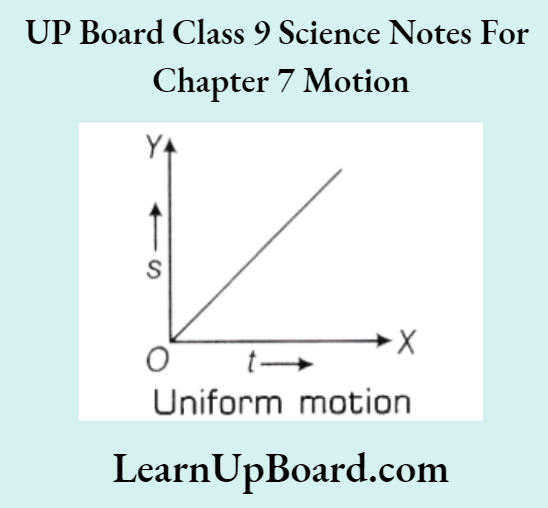
The distance-time graph for the non-uniform motion of an object is a curved line.
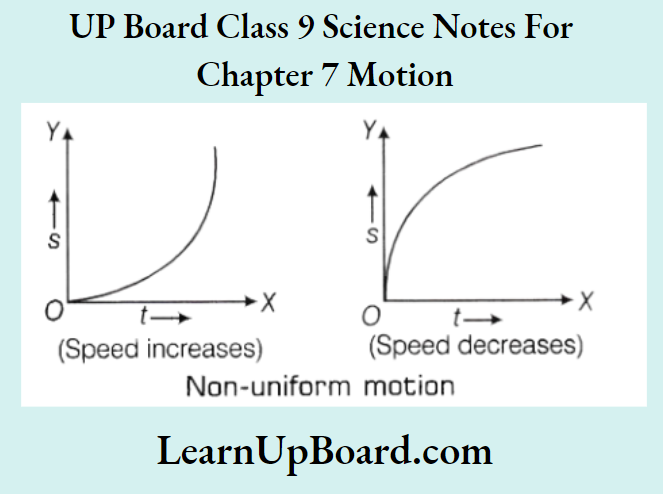
Question 13. What can you say about the motion of an object whose distance-time graph is a straight line parallel to the time axis?
Answer:
When an object is at rest, then its distance-time graph is a straight line parallel to the 8-time axis. Thus, it indicates 3 that with a change in time, 5 there is no change in the position of the object, i.e. the Time — object is at rest.
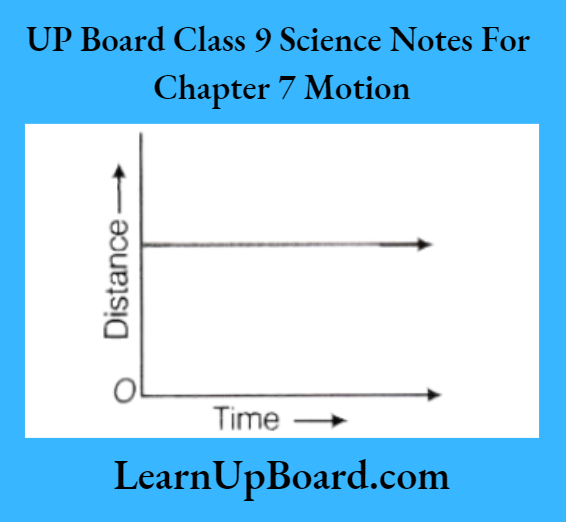
Question 14. What can you say about the motion of an object, if its speed-time graph is a straight line parallel to the time axis?
Answer:
A straight line parallel to the time axis in a speed-time graph indicates that a change in time, there is no change in the speed of the object. This indicates the speed of the object is constant.

Question 15. What is the quantity which is measured by the area occupied below the velocity-time graph?
Answer:
The displacement is measured by the area occupied below the velocity-time graph.
UP Board Class 9 Science Notes For Chapter 7 Exercises
Question 1. An athlete completes one round of a circular track of diameter 200 m in 40 s. What will be the distance covered and the displacement at the end of 2 min 20 s?
Answer:
According to the question,
An athlete completes one round of a circular track of diameter 200 m in 40 s.
diameter of the circular track = 200 m
Hence, radius =100 m
In 40 s, an athlete completes 1 round.
In 140 s, an athlete completes \(\frac{140}{40}=3 \frac{1}{2}\) rounds.
Hence, the distance covered by the athlete
= 3 \(\times 2 \pi r+\frac{1}{2} \times 2 \pi r\)
= 3 \(\times 2 \times \frac{22}{7} \times 100+\frac{1}{2} \times 2 \times \frac{22}{7} \times 100\)
= 2200 m
Displacement = Shortest path between the initial position and the final position = 2 r = 2 x 100 = 200 m
Question 2. Joseph jogs from one end A to the other end B of a straight 300 m road in 2 min 30 s and then turns around and jogs 100 m back to point C in another 1 min. What are Joseph’s average speeds and velocities in jogging (1) from A to B and (2) from A to C?
Answer:
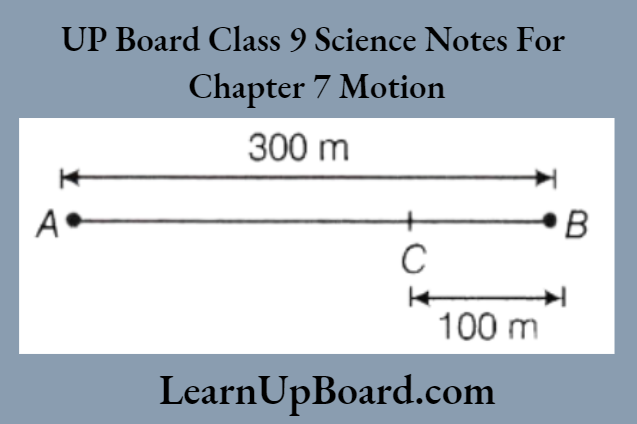
Given
Joseph jogs from one end A to the other end B of a straight 300 m road in 2 min 30 s and then turns around and jogs 100 m back to point C in another 1 min
1. From A to B, Joseph covers distance = 300 m
Time = 2 min 30 s = 2 x 60 + 30
Hence, average speed =\(\frac{\text { total distance }}{\text { total time }}\)
=\(\frac{300}{150}=2 \mathrm{~m} / \mathrm{s}\)
Average velocity =\(\frac{\text { Total displacement }}{\text { Total time }}=\frac{300}{150}\)
= 2 m/s
Au in both cases, the distance covered and direction are the same.
2. From A to C, Joseph covers distance = 400 m
Time = 150 + 60 – 210 s
Hence, average speed =\(\frac{400}{210}=1.9 \mathrm{~m} / \mathrm{s}\)
Displacement =200 m
Time =150+60=210 s
Hence, average velocity = \(\frac{200}{210}=0.952 \mathrm{~m} / \mathrm{s}\)
Question 3. Abdul, while driving to school, computes the average speed for his trip to be 20 km/h. On his return trip along the same route, there is less traffic and the average speed is 30 km/h. What is the average speed for Abdul’s trip?
Answer:
Given
Abdul, while driving to school, computes the average speed for his trip to be 20 km/h. On his return trip along the same route, there is less traffic and the average speed is 30 km/h
Let the distance covered by Abdul while driving to school =x
While going \(v_1=20=\frac{x}{t_1}\) [where, \(t_1\)= time taken to cover distance x ]
While returning \(v_2=30=\frac{x}{t_2}\) [where, \(t_2\)= time taken to cover x while returning]
Hence, \(t_1=\frac{x}{20}, t_2=\frac{x}{30}\)
Average speed =\(\frac{\text { Total distance }}{\text { Total time }}=\frac{2 x}{\frac{x}{20}+\frac{x}{30}}=\frac{2 x}{\frac{5 x}{60}}\)
=\(\frac{2 x \times 60}{5 x}=24 \mathrm{~km} / \mathrm{h}\)
Question 4. A driver of a car travelling at 52 km/h applies the brakes and accelerates uniformly in the opposite direction. The car stops in 5 s. Another driver going at 3 km/h in another car applies his brakes slowly and stops in 10 s. On the same graph paper, plot the speed versus time graphs for the two cars. Which of the two cars travelled farther after the brakes were applied?
Answer:
Given
A driver of a car travelling at 52 km/h applies the brakes and accelerates uniformly in the opposite direction. The car stops in 5 s. Another driver going at 3 km/h in another car applies his brakes slowly and stops in 10 s. On the same graph paper, plot the speed versus time graphs for the two cars.
Initial speed of car A =52 \(\mathrm{~km} / \mathrm{h}=52 \times \frac{5}{18} \)
=14.44 m/s
The car stops in 5 s, i.e. final speed of the car, v=0, time, t=5 s. For a speed-time graph of car A,
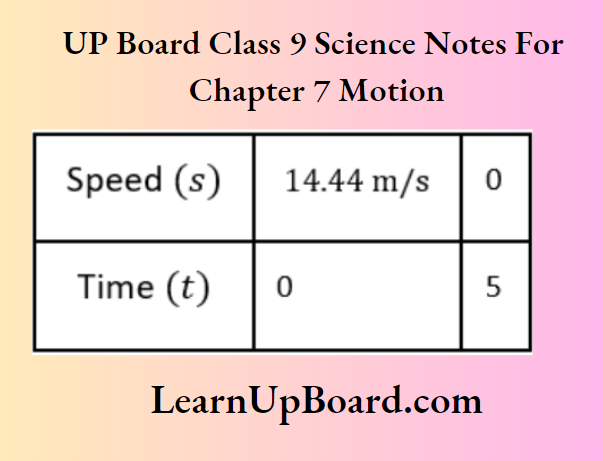
Initial speed of car B=3 km/h=3 \(\times \frac{5}{18}=0.83 \mathrm{~m} / \mathrm{s}\)
The car stops in 10s, i.e. final speed of the car, v=0, time, t=10s.
For a speed-time graph of car B,
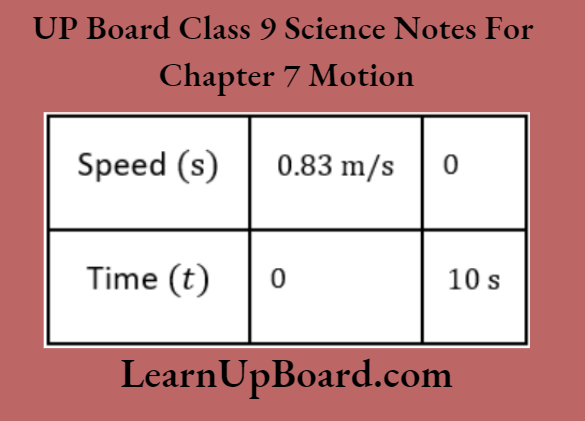
The speed-time graph of both cars A and B is shown below:
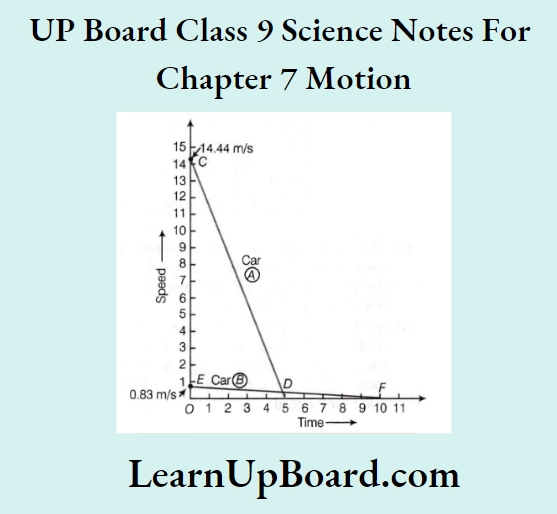
Distance travelled by car A= Area of \(\triangle\) OCD
=\(\frac{1}{2} O C \times O D=\frac{1}{2} \times 14.44 \times\) 5=36.1 m
Distance travelled by car B= Area of \(\triangle\) OEF
= \(\frac{1}{2} O E \times E F \)
= \(\frac{1}{2} \times 0.83 \times 10\)=4.15 m
Thus, car A travelled farther than car B after the brakes were applied.
Question 5. The figure shows the distance-time graph of three objects A B and C. Study the graph and answer the following questions:
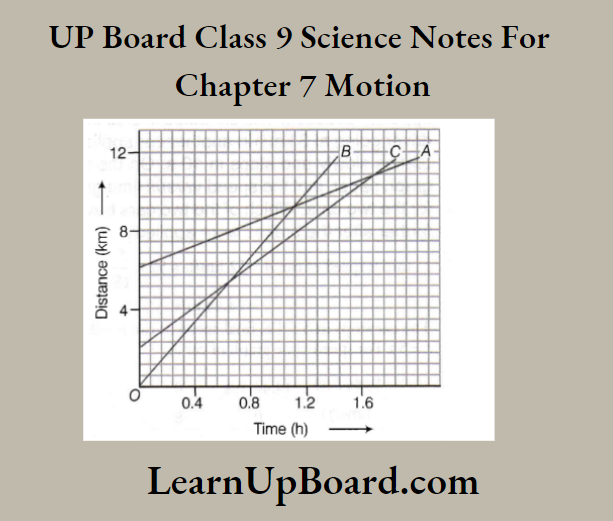
- Which of the three is travelling the fastest?
- Are all three ever at the same point on the road?
- How far has C travelled when B passes A?
- How far has B travelled by the time it passes C?
Answer:
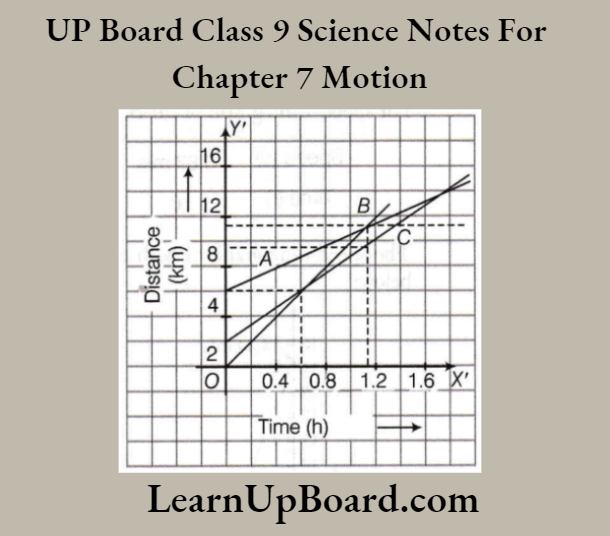
- The object for which the slope of the distance-time graph is maximum will have maximum speed, i.e. will travel the fastest. Here, for object B, the slope is maximum, so it is travelling the fastest.
- All three objects will be at the same point on the road if the speed-time graph intersects each other at any point. Here, all three graphs do not intersect each other, so these three will never be at the same point on the road.
- When B passes A, then the distance travelled by C =9.6 – 2 = 7.6 km
- Distance travelled by B when it passes C =6 km.
Question 6. The speed-time graph for a car is shown in the below figure:
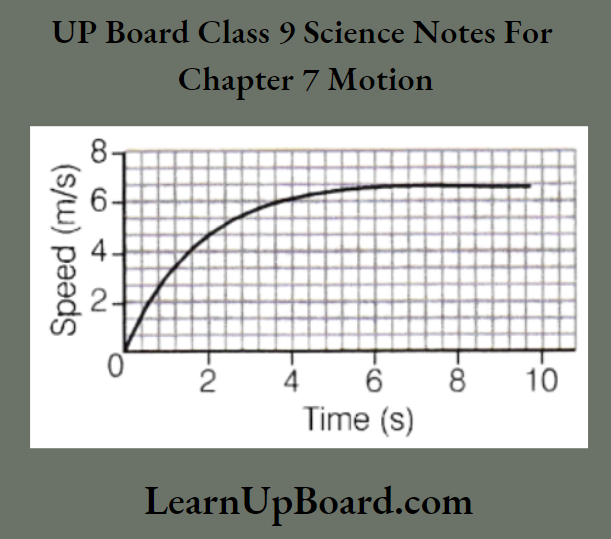
- Find how far the car travels in the first 4 s. Shade the area on the graph that represents the distance travelled by the car during the period.
- Which part of the graph represents the uniform motion of the car?
Answer:
The area under the slope of the speed-time graph gives the distance travelled by an object.
(1) We will calculate the distance represented by 1 square of the graph.
This can be done as follows. If 5 square on X-axis = 2 s,
1 square on X-axis = 2/5 s,
3 square on Y-axis = 2 m/s,
1 square on Y-axis = 2/3 m/s
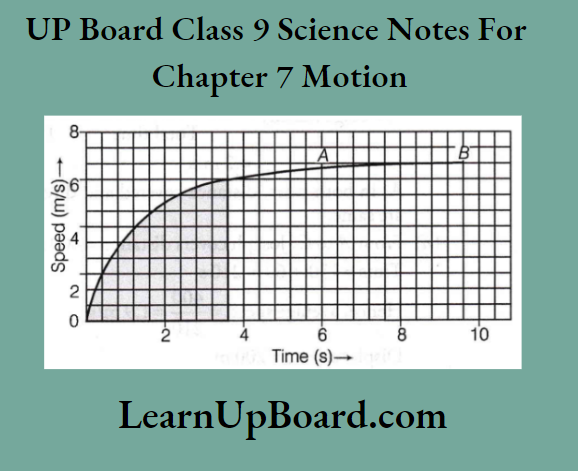
So, area of 1 square on graph =\(\frac{2}{5} \times \frac{2}{3}\)
= \(\frac{4}{15} \mathrm{~m}\)
distance =\(\frac{4}{15} \mathrm{~m}\)
1 square represents distance =\(\frac{4}{15} \mathrm{~m}\)
Since approximately 62 squares come under the area of slope for the time of 4 s.
So, distance travelled in 4 s=\(\frac{4}{15} \times 62=16.53 \mathrm{~m}\)
(2) For uniform motion, the speed-time graph is a straight line parallel to the time axis. So, the straight part of the curve parallel to the time axis represents the uniform motion of the car.
Question 7. State which of the following situations are possible and give an example for each.
- An object with a constant acceleration but with zero velocity.
- An object is moving in a certain direction with an acceleration in the perpendicular direction.
Answer:
- When an object is thrown vertically upward, then at the highest point its velocity is zero but it has a constant acceleration of 9.8 m/s2 (acceleration due to gravity).
- An aeroplane flies in a horizontal direction but the acceleration due to gravity acts on it in a vertically downward direction, i.e. along the direction perpendicular to the direction of motion.
Question 8. An artificial satellite is moving in a circular orbit of radius 42250 km. Calculate its speed, if it takes 24 hours to revolve around the earth.
Answer:
Given, the radius of the orbit, r=42250 km
Distance covered in one revolution,
d =2 \(\pi r\) [circumference of the orbit]
=2 \(\times \frac{22}{7} \times 42250=265571.43 \mathrm{~km}\)
Time taken in one revolution, t=24 h
Speed of satellite =\(\frac{\text { Distance }}{\text { Time }}=\frac{265571.43}{24}\)
=11065.48 \(\mathrm{~km} / \mathrm{h}\)
UP Board Class 9 Science Notes For Chapter 7 Summary
- An object is said to be in motion if its position changes with time.
- The distance travelled by a body is the actual length of the path covered by it, irrespective of the direction in which the body travels.
- It is a scalar quantity. Its SI unit is metre.
- The shortest distance between the initial and final position of the moving object is called the displacement of the object. It is a vector quantity. Its SI unit is metre.
- The ratio of distance travelled by an object to the time taken is called the rate of motion.
- The speed of an object is defined as the distance travelled by it in unit time.
- Speed of an object (v) = \(\frac{\text { Distance }(s)}{\text { Time }(t)}\)
- It is a scalar quantity. Its SI unit is metres per second (m/s).
- The velocity of an object is defined as the displacement of the body per unit time.
- Velocity of an object (v)=\(\frac{\text { Displacement }(d)}{\text { Time }(t)}\)
- It is a vector quantity. Its SI unit is metres per second (m/s).
- Acceleration is defined as the rate of change of velocity with respect to time.
- Acceleration (a)=\(\frac{\text { Change in velocity }(\Delta v)}{\text { Change in time }(\Delta t)}\)
- It is a vector quantity. Its SI unit is m/s2.
Types of acceleration
- Uniform acceleration If the velocity of an object changes by an equal amount in equal intervals of time, then the acceleration of the object is known as uniform acceleration.
- Non-uniform acceleration If the velocity of an object changes by an unequal amount in equal intervals of time, then the acceleration of the object is known as non-uniform acceleration.
- When an object moves in a circular path with a uniform
- speed, its motion is called uniform circular motion.

